
e-mail :  ( Please write in ' Subject ' entry : ' METAPHYSICS ', in order for me to be able to distinguish your mail from spam )
( Please write in ' Subject ' entry : ' METAPHYSICS ', in order for me to be able to distinguish your mail from spam )
Evolution of Insects in terms of the Implicate and Explicate Orders.
Part IIIb
The Blattaria fauna of the Wettiner Basin
( Wettin and Löbejün near Halle, Germany )
Both fossil insect localities of the Wettiner basin, Wettin and Löbejün, long since known, lie in the former DDR, about 20 km N.N.W. of the city of Halle, Germany. They geologically belong to the Ottweiler Stufe, Upper upper-Carboniferous. The Wettiner basin is, like the Saar basin, a limnic inland depression. As to the fossil Blattida, also here the majority belongs to the family Archimylacridae. The geological and ecological status is largely similar to that of the Saar basin (see previous two documents).
The literature in which the fossil Blattida of the Wettin basin are described :
- HANDLIRSCH, A., Die fossilen Insekten ud die Phylogenie der rezenten Formen, 1906-8.
- SCHLECHTENDAL, D. v., Untersuchung über die karbonischen Insekten und Spinnen von Wettin, unter Berücksichtigung verwanter Faunen. Erster Teil : Revision der Originale von Germar, Giebel und Goldenberg. 1912 [appeared in 1913, in NOVA ACTA. Abh. der Kaiserl. Leop.-Carol. Deutschen Akademie der Naturforscher. Band XCVIII. Nr.1.]
We will now list and depict the sufficiently well-preserved fossil Blattida of the Wettiner basin (localities : Wettin, Löbejün) :
Frame 1 :
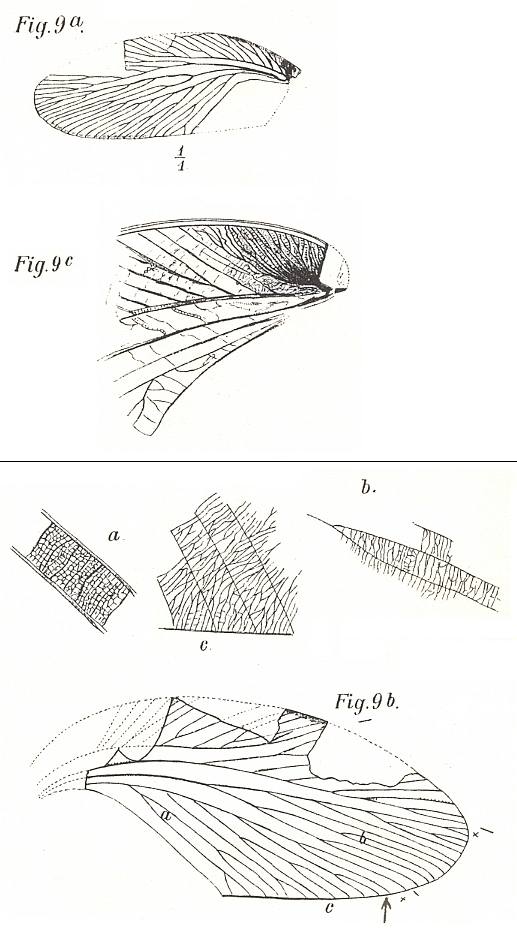
Frame 2 :
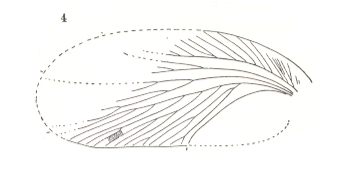
Frame 3 :
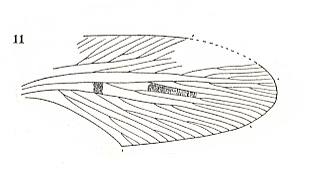
|
Frame 1 :
Anthracoblattina spectabilis GOLDENBERG
Family Archimylacridae.
Length of tegmen (Fig.9a) about 45 mm.
Locality : Löbejün in Sachsen.
Stratum : Ottweiler Stufe, upper Upper-Carboniferous.
Figure 9a (upper image) [including Fig. 9c (second image, detail of wing-base)] is the counterpart of what is depicted in Figure 9b (bottom image of frame 1).
In this bottom image (of frame 1) a, c, and b depict the archedictyon of the areas a, c, and b in Figure 9b.
The arrow in Fig. 9b indicates the location where SCHLECHTENDAL has forgotten to draw a simple vein (5th branching of CuA).
(Figure 9a, 9b, 9c after SCHLECHTENDAL, 1912, Tab.VI, fig. 9abc)
Fig. 9a is the same specimen as the one depicted in Fig. 4 in Taf.XXI in HANDLIRSCH, 1906. ( Frame 2 ).
Fig. 9b is the same specimen as the one depicted in Fig. 11 in Taf.XIX in HANDLIRSCH, 1906. ( Frame 3 ).
Frame 2 :
Auxanoblatta saxonica HANDLIRSCH
Family Archimylacridae.
Length of fragment about 39 mm.
Locality : Löbejün in Sachsen.
Stratum : Ottweiler Stufe, Upper Upper-Carboniferous.
(After HANDLIRSCH, 1906, p.202, Taf.XXI, Fig.4)
(= Anthracoblattina spectabilis Gold. = counterpart of that depicted in Frame 3. (SCHLECHTENDAL, 1912))
Frame 3 :
Anthracoblattina spectabilis GOLDENBERG
Family Archimylacridae.
Length of fragment about 37 mm.
Locality : Löbejün in Sachsen.
Stratum : Ottweiler Stufe, Upper Upper-Carboniferous.
(After HANDLIRSCH, 1906, p.189, Taf.XIX, fig.11)
(See also SCHLECHTENDAL, 1912, p.76, p.73)
|
Frame 4 :
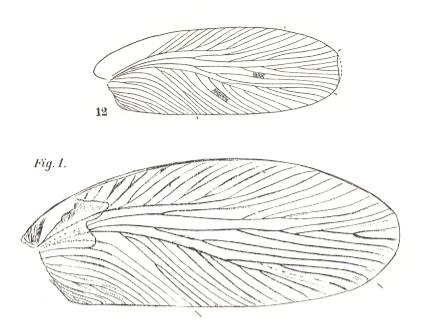
|
Frame 4 :
Anthracoblattina didyma ROST.
Family Archimylacridae.
Length of tegmen about 38 mm.
Locality : Wettin in Sachsen.
Stratum : Ottweiler Stufe,
upper Upper-Carboniferous.
Both images : presumably same specimen.
(Figure 12 : after HANDLIRSCH, 1906, Taf.XIX, fig. 12. See, in addition, p.189)
(Figure 1 : after SCHLECHTENDAL, 1912, Tab.V, fig.1)
|
Frame 5 :
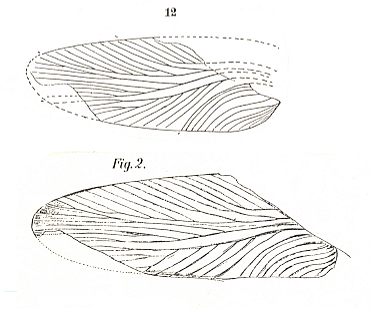
|
Frame 5 :
Asemoblatta anthracophila GERMAR
Family Archimylacridae.
Length of tegmen about 25 mm.
Locality : Wettin in Sachsen.
Stratum : Ottweiler Stufe,
upper Upper-Carboniferous.
Both images : same specimen.
(Upper image after HANDLIRSCH, 1906, p.204, Taf.XXI, fig.12)
(See also SCHLECHTENDAL, 1912, p.18)
(Lower image : after SCHLECHTENDAL, 1912, Taf.V, fig.2)
|
Frame 6 :
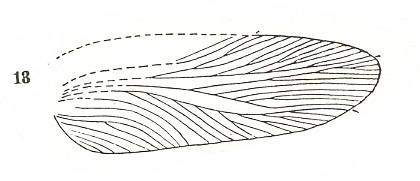
|
Frame 6 :
Asemoblatta gemella SCHLECHTENDAL
Family Archimylacridae.
Length of tegmen about 21 mm.
Locality : Löbejün in Sachsen.
Stratum : Ottweiler Stufe, upper Upper-Carboniferous.
(After HANDLIRSCH, 1906, p.204)
|
Frame 7 :
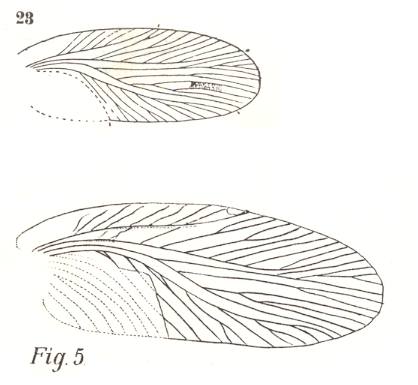
|
Frame 7 :
Phyloblatta Schröteri GIEBEL
Family Archimylacridae.
Length of tegmen about 17 mm.
Locality : Löbejün in Sachsen.
Stratum : Ottweiler Stufe, upper Upper-Carboniferous.
Both images same specimen.
(Upper image after HANDLIRSCH, 1906, description at p.207)
(See also SCHLECHTENDAL, 1912, p.53)
(Lower image after SCHLECHTENDAL, 1912, Tab.VI, fig.5)
|
Frame 8 :
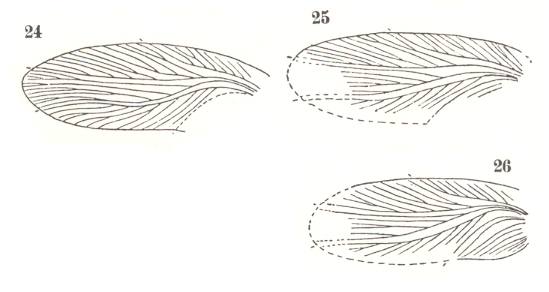
|
Frame 8 :
Phyloblatta Scheibeana SCHLECHTENDAL
Family Archimylacridae.
Length of tegmina about 17 mm.
Locality : Wettin in Sachsen.
Stratum : Ottweiler Stufe,
upper Upper-Carboniferous.
Three specimens.
(After HANDLIRSCH, 1906, description p.207)
|
Frame 9 :
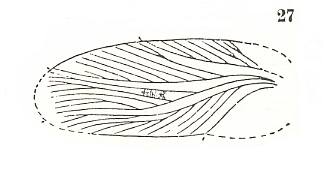
|
Frame 9 :
Phyloblatta venosa SCHLECHTENDAL
Family Archimylacridae.
Length of tegmen about 16 mm.
Locality : Wettin in Sachsen.
Stratum : Ottweiler Stufe,
upper Upper-Carboniferous.
(After HANDLIRSCH, 1906, p.207)
|
Frame 10 :
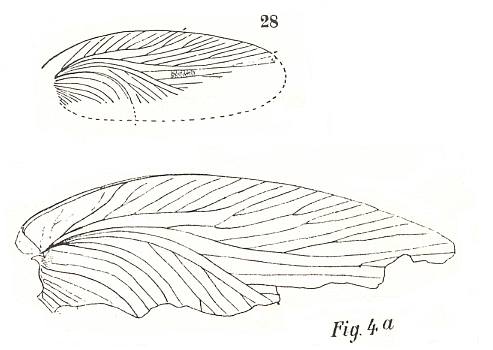
|
Frame 10 :
Phyloblatta ramosa GIEBEL
Family Archimylacridae.
Length of tegmen about 16 mm.
Locality : Löbejün in Sachsen.
Stratum : Ottweiler Stufe,
upper Upper-Carboniferous.
(Upper image after HANDLIRSCH, 1906, Taf.XXI, fig.28, description at p.208)
(Bottom image after SCHLECHTENDAL, 1912, Tab.VI, fig.4)
|
Frame 11 :
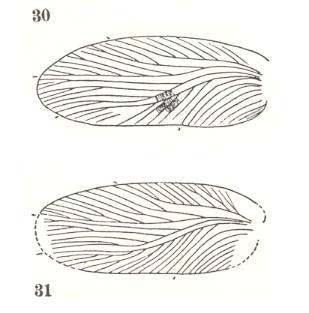
|
Frame 11 :
Phyloblatta saueriana SCHLECHTENDAL
Family Archimylacridae.
Length of tegmina about 17 mm.
Locality : Löbejün in Sachsen.
Stratum : Ottweiler Stufe, upper Upper-Carboniferous.
(After HANDLIRSCH, 1906, description at p.208)
Two specimens, a third one not given here, because the illustration was defective for reproduction as a result of bookbinding factors.
|
Frame 12 :
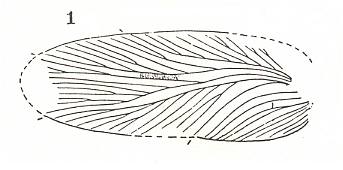
|
Frame 12 :
Phyloblatta splendens SCHLECHTENDAL
Family Archimylacridae.
Length of tegmina about 19 mm.
Locality: Wettin in Sachsen.
Stratum : Ottweiler Stufe, upper Upper-Carboniferous.
(After HANDLIRSCH, 1906, Taf.XXII, fig.1, description at p.208)
|
Frame 13 :
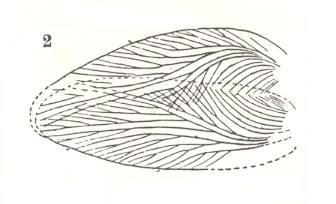
|
Frame 13 :
Phyloblatta Fritschi SCHLECHTENDAL
Family Archimylacridae.
Length of tegmina about 18 mm.
Locality : Wettin in Sachsen.
Stratum : Ottweiler Stufe, upper Upper-Carboniferous.
(After HANDLIRSCH, 1906, Taf.XXII, fig.2, description at p.209)
|
Frame 14 :
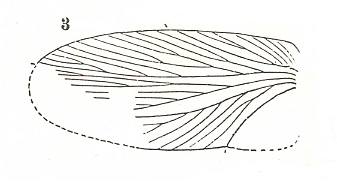
|
Frame 14 :
Phyloblatta intermedia SCHLECHTENDAL
Family Archimylacridae.
Length of tegmen about 21 mm.
Locality : Löbejün in Sachsen.
Stratum : Ottweiler Stufe, upper Upper-Carboniferous.
(After HANDLIRSCH, 1906, Taf.XXII, fig.3, description at p.209)
Extreme right edge of drawing a little deformed during reproduction.
|
Frame 15 :
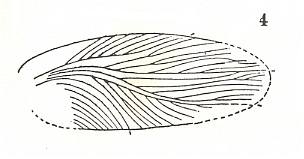
|
Frame 15 :
Phyloblatta munda SCHLECHTENDAL
Family Archimylacridae.
Length of tegmen about 17 mm.
Locality : Wettin in Sachsen.
Stratum : Ottweiler Stufe, upper Upper-Carboniferous.
(After HANDLIRSCH, 1906, Taf.XXII, fig.4, description at p.209)
|
Frame 16 :
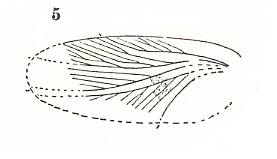
|
Frame 16 :
Phyloblatta amoena SCHLECHTENDAL
Family Archimylacridae.
Length of fragment about 13 mm.
Locality: Wettin in Sachsen.
Stratum : Ottweiler Stufe, upper Upper-Carboniferous.
(After HANDLIRSCH, 1906, Taf.XXII, fig.5, )
|
Frame 17 :
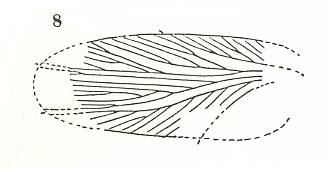
|
Frame 17 :
Phyloblatta irregularis SCHLECHTENDAL
Family Archimylacridae.
Length of fragment about 14 mm.
Locality : Löbejün in Sachsen.
Stratum : Ottweiler Stufe, upper Upper-Carboniferous.
(After HANDLIRSCH, 1906, Taf.XXII, fig.8, description p.210)
|
Frame 18 :
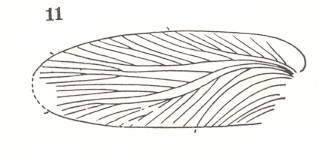
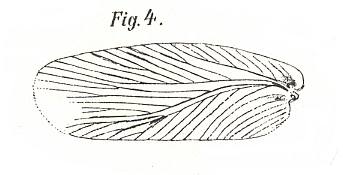
|
Frame 18 :
Phyloblatta flabellata GERMAR
Family Archimylacridae.
Length of tegmen about 18 mm.
Locality : Wettin in Sachsen.
Stratum : Ottweiler Stufe, upper Upper-Carboniferous.
(Upper image after HANDLIRSCH, 1906, Taf.XXII, fig.11, description p.211)
(Lower image after SCHLECHTENDAL, 1912, Tab.V, fig.4)
Both images are of the same specimen.
|
Frame 19 :
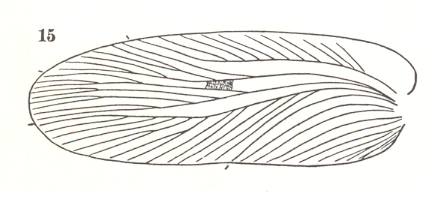
|
Frame 19 :
Phyloblatta wittekindiana SCHLECHTENDAL
Family Archimylacridae.
Length of tegmen about 27 mm.
Locality : Bad Wittekind near Halle.
Stratum : Ottweiler Stufe,
upper Upper-Carboniferous.
(After HANDLIRSCH, 1906, Taf.XXII, fig.15, description p.212)
|
Frame 20 :

|
Frame 20 :
Phyloblatta plana SCHLECHTENDAL
Family Archimylacridae.
Length of tegmen about 26 mm.
Locality : Wettin in Sachsen.
Stratum : Ottweiler Stufe,
upper Upper-Carboniferous.
(After HANDLIRSCH, 1906, Taf.XXII, fig.16, description p.213)
|
Frame 21 :
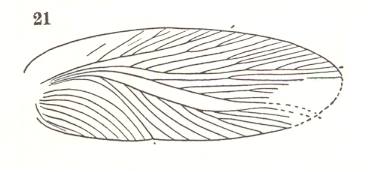
|
Frame 21 :
Phyloblatta imbecilla SCHLECHTENDAL
Family Archimylacridae.
Length of tegmen about 23 mm.
Locality : Löbejün in Sachsen.
Stratum : Ottweiler Stufe,
upper Upper-Carboniferous.
(After HANDLIRSCH, 1906, Taf.XXII, fig.21, description p.214)
|
Frame 22 :
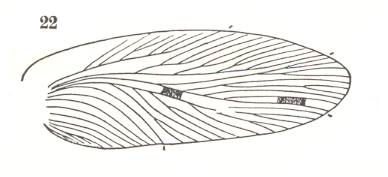
|
Frame 22 :
Phyloblatta exilis SCHLECHTENDAL
Family Archimylacridae.
Length of tegmen about 24 mm.
Locality : Löbejün in Sachsen.
Stratum : Ottweiler Stufe,
upper Upper-Carboniferous.
(After HANDLIRSCH, 1906, Taf.XXII, fig.22, description p.214)
|
Frame 23 :
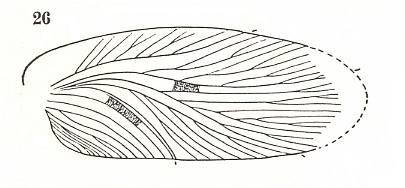
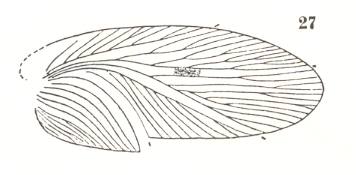
|
Frame 23 :
Phyloblatta rugulosa SCHLECHTENDAL
Family Archimylacridae.
Length of tegmen about 24-23 mm (resp. upper, lower image).
Locality : Wettin and Löbejün in Sachsen.
Stratum : Ottweiler Stufe,
upper Upper-Carboniferous.
Two specimens.
(After HANDLIRSCH, 1906, Taf.XXII, fig.26 and 27, description p.215)
|
Frame 24 :
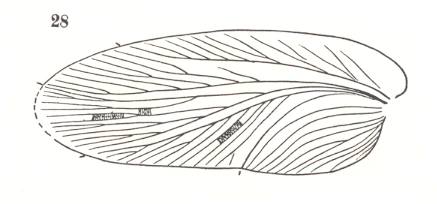
|
Frame 24 :
Phyloblatta tristis SCHLECHTENDAL
Family Archimylacridae.
Length of tegmen about 24 mm.
Locality : Löbejün in Sachsen.
Stratum : Ottweiler Stufe,
upper Upper-Carboniferous.
(After HANDLIRSCH, 1906, Taf.XXII, fig.28, description p.215)
|
Frame 25 :
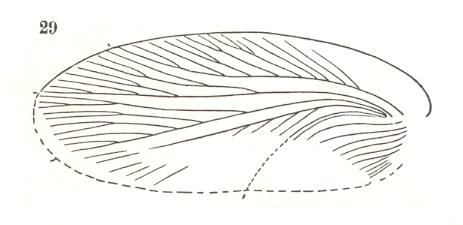
|
Frame 25 :
Phyloblatta Credneri SCHLECHTENDAL
Family Archimylacridae.
Length of tegmen about 25 mm.
Locality : Löbejün in Sachsen.
Stratum : Ottweiler Stufe,
upper Upper-Carboniferous.
(After HANDLIRSCH, 1906, Taf.XXII, fig.29, description p.216)
|
Frame 26 :
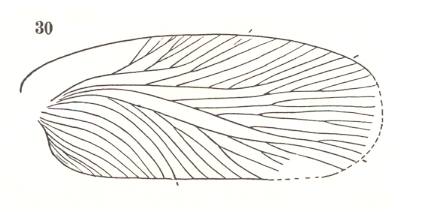
|
Frame 26 :
Phyloblatta incerta SCHLECHTENDAL
Family Archimylacridae.
Length of tegmen about 25 mm.
Locality : Löbejün in Sachsen.
Stratum : Ottweiler Stufe,
upper Upper-Carboniferous.
(After HANDLIRSCH, 1906, Taf.XXII, fig.30, description p.216)
|
Frame 27 :
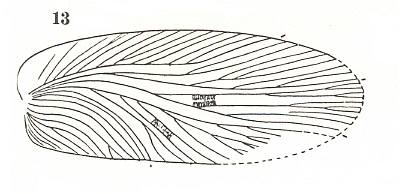
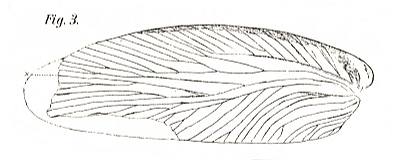
|
Frame 27 :
Phyloblatta anaglyptica GERMAR
Family Archimylacridae.
Length of tegmen about 26 mm.
Locality : Wettin in Sachsen.
Stratum : Ottweiler Stufe,
upper Upper-Carboniferous.
In the figure, shoulder of tegmen deformed in photocopying it from Handlirsch' Tafel.
(Upper image after HANDLIRSCH, 1906, Taf.XXII, fig.13, description p.212)
(Lower image after SCHLECHTENDAL, 1912, Tab.V, fig.3)
See also SCHLECHTENDAL, 1912, p.14-17.
Both images of the same specimen.
|
Frame 28 :
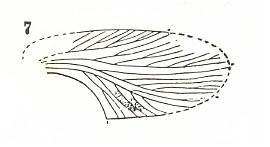
|
Frame 28 :
Phyloblatta mollis SCHLECHTENDAL
Family Archimylacridae.
Length of tegmen at least 13 mm.
Locality : Wettin in Sachsen.
Stratum : Ottweiler Stufe,
upper Upper-Carboniferous.
(After HANDLIRSCH, 1906, Taf.XXII, fig.7, description p.210)
|
Frame 29 :
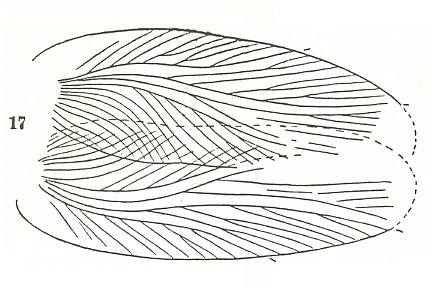
|
Frame 29 :
Phyloblatta grata SCHLECHTENDAL
Family Archimylacridae.
Length of tegmina about 30 mm.
Locality : Wettin in Sachsen.
Stratum : Ottweiler Stufe,
upper Upper-Carboniferous.
(After HANDLIRSCH, 1906, Taf.XXII, fig.17, description p.213)
|
Frame 30 :
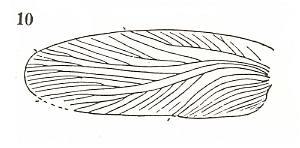
|
Frame 30 :
Phyloblatta elegans SCHLECHTENDAL
Family Archimylacridae.
Length of tegmen about 16 mm.
Locality : Löbejün in Sachsen.
Stratum : Ottweiler Stufe,
upper Upper-Carboniferous.
(After HANDLIRSCH, 1906, Taf.XXII, fig.10, description p.211)
|
Frame 31 :
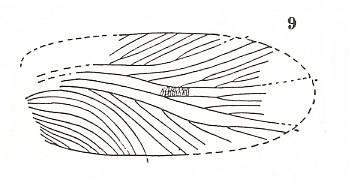
|
Frame 31 :
Phyloblatta ardua SCHLECHTENDAL
Family Archimylacridae.
Length of tegmen about 18 mm.
Locality : Wettin in Sachsen.
Stratum : Ottweiler Stufe,
upper Upper-Carboniferous.
(After HANDLIRSCH, 1906, Taf.XXII, fig.9, description p.211)
|
Frame 32 :
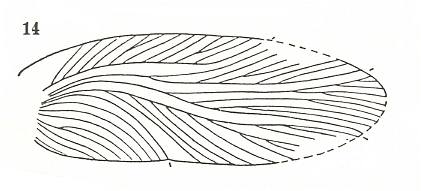
|
Frame 32 :
Phyloblatta Hochecornei SCHLECHTENDAL
Family Archimylacridae.
Length of tegmen about 27 mm.
Locality : Löbejün in Sachsen.
Stratum : Ottweiler Stufe,
upper Upper-Carboniferous.
(After HANDLIRSCH, 1906, Taf.XXII, fig.14, description p.212)
|
Frame 33 :
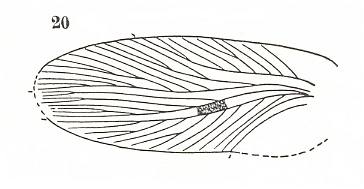
|
Frame 33 :
Phyloblatta difficilis SCHLECHTENDAL
Family Archimylacridae.
Length of tegmen about 22 mm.
Locality : Wettin in Sachsen.
Stratum : Ottweiler Stufe,
upper Upper-Carboniferous.
(After HANDLIRSCH, 1906, Taf.XXII, fig.20, description p.213)
|
Frame 34 :
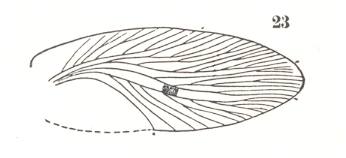
|
Frame 34 :
Phyloblatta honesta SCHLECHTENDAL
Family Archimylacridae.
Length of tegmen about 19 mm.
Locality : Wettin in Sachsen.
Stratum : Ottweiler Stufe,
upper Upper-Carboniferous.
(After HANDLIRSCH, 1906, Taf.XXII, fig.23, description p.214)
|
Frame 35 :
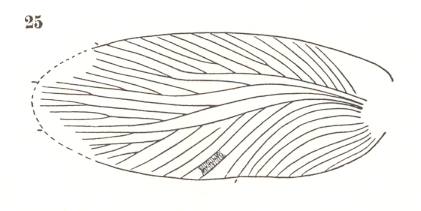
|
Frame 35 :
Phyloblatta Schröteriana SCHLECHTENDAL
Family Archimylacridae.
Length of tegmen about 25 mm.
Locality : Löbejün in Sachsen.
Stratum : Ottweiler Stufe,
upper Upper-Carboniferous.
(After HANDLIRSCH, 1906, Taf.XXII, fig.25, description p.215)
|
Frame 36 :
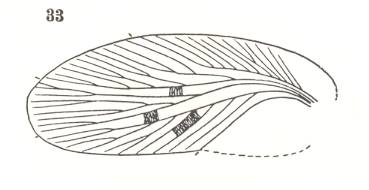
|
Frame 36 :
Phyloblatta perfecta SCHLECHTENDAL
Family Archimylacridae.
Length of tegmen about 21 mm.
Locality : Wettin in Sachsen.
Stratum : Ottweiler Stufe,
upper Upper-Carboniferous.
(After HANDLIRSCH, 1906, Taf.XXII, fig.33, description p.217)
|
Frame 37 :
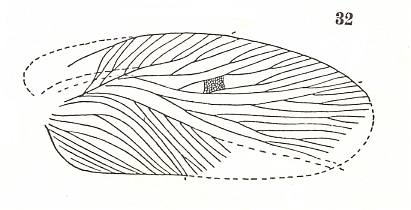
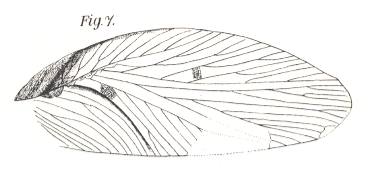
|
Frame 37 :
Phyloblatta russoma GOLDENBERG
Family Archimylacridae.
Length of tegmen about 22 mm.
Locality : Löbejün in Sachsen.
Stratum : Ottweiler Stufe,
upper Upper-Carboniferous.
Both images of the same specimen.
(Upper image after HANDLIRSCH, 1906, Taf.XXII, fig.32, description p.217)
(Lower image after SCHLECHTENDAL, 1912, Tab.VI, fig.7)
(and see SCHLECHTENDAL. 1912, p.64)
|
Frame 38 :
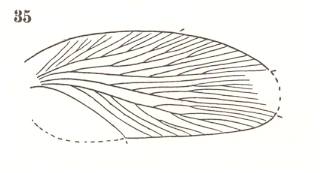
|
Frame 38 :
Phyloblatta lepida SCHLECHTENDAL
Family Archimylacridae.
Length of tegmen about 19 mm.
Locality : Wettin in Sachsen.
Stratum : Ottweiler Stufe,
upper Upper-Carboniferous.
(After HANDLIRSCH, 1906, Taf.XXII, fig.35, description p.217)
|
Frame 39 :
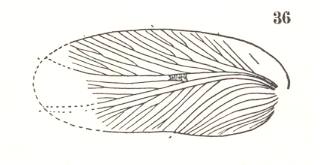
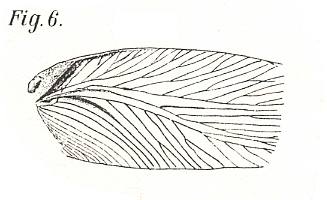
|
Frame 39 :
Phyloblatta leptophlebia GOLDENBERG
Family Archimylacridae.
Length of tegmen about 18 mm.
Locality : Löbejün in Sachsen.
Stratum : Ottweiler Stufe,
upper Upper-Carboniferous.
Both images of the same specimen.
(Upper image after HANDLIRSCH, 1906, Taf.XXII, fig.36, description p.218)
(Lower image after SCHLECHTENDAL, 1912, Tab. VI, fig.6)
(and see SCHLECHTENDAL, 1912, p.61)
(GOLDENBERG writes "leptophlebica", which, also in grammatical respect, should be written that way.)
|
The figures corresponding to the numbers 6, 12, 19, 24, 31, and 34 in Tafel XXII in HANDLIRSCH, 1906, are not reproduced here because the figures are distorted as a result of bookbinding.
I do, however, give the names of the described fossils corresponding with these numbers :
Phyloblatta Geinitzi GOLDENBERG
Family Archimylacridae.
Length of fragment 14 mm.
Locality : Löbejün in Sachsen.
Stratum : Ottweiler Stufe, upper Upper-Carboniferous.
(HANDLIRSCH, 1906, description p.210)
See also SCHLECHTENDAL. 1912, p.69, and from this work (Tab.VI, fig.8) a figure of this fossil is available :
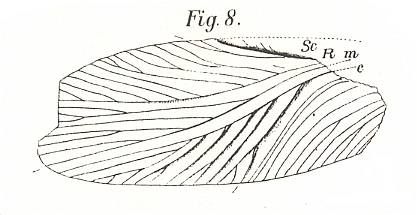
(After SCHLECHTENDAL, 1912)
Phyloblatta modica SCHLECHTENDAL
Family Archimylacridae.
Locality : Löbejün in Sachsen.
Stratum : Ottweiler Stufe, upper Upper-Carboniferous.
(HANDLIRSCH, 1906, description p.211)
Phyloblatta efferata SCHLECHTENDAL
Family Archimylacridae.
Locality : Wettin in Sachsen.
Stratum : Ottweiler Stufe, upper Upper-Carboniferous.
(HANDLIRSCH, 1906, description p.213)
Phyloblatta callosa SCHLECHTENDAL
Family Archimylacridae.
Locality : Plötz in Sachsen.
Stratum : Ottweiler Stufe, upper Upper-Carboniferous.
(HANDLIRSCH, 1906, description p.215)
Phyloblatta wettinensis SCHLECHTENDAL
Family Archimylacridae.
Locality : Wettin in Sachsen.
Stratum : Ottweiler Stufe, upper Upper-Carboniferous.
(HANDLIRSCH, 1906, description p.216)
Phyloblatta soluta SCHLECHTENDAL
Family Archimylacridae.
Locality : Wettin in Sachsen.
Stratum : Ottweiler Stufe, upper Upper-Carboniferous.
(HANDLIRSCH, 1906, description p.217)
* * *
In what comes next we will continue to depict fossil Blattida from Wettin and surroundings, as they have been drawn in Tafel XXIII of HANDLIRSCH's "Die fossilen Insekten of 1906.
The following of these drawings, however, are, as a result of bookbinding, too defective to be reproduced here : fig. 3, 8, 13, 17, 26, and 31. They will be listed.
The next drawings in HANDLIRSCH I will not consider at all, because the fossils are too fragmentary : fig. 36, 38, 42, 40, 39, 41, 37, and 44.
We will now list the above Blattida species.
Phyloblatta obsoleta SCHLECHTENDAL
Locality : Wettin in Sachsen.
Stratum : Ottweiler Stufe, upper Upper-Carboniferous.
HANDLIRSCH, 1906, p.225
Phyloblatta angustata SCHLECHTENDAL
Locality : Wettin in Sachsen.
Stratum : Ottweiler Stufe, upper Upper-Carboniferous.
HANDLIRSCH, 1906, p.218
Phyloblatta exasperata SCHLECHTENDAL
Locality : Löbejün in Sachsen.
Stratum : Ottweiler Stufe, upper Upper-Carboniferous.
HANDLIRSCH, 1906, p.221
Phyloblatta Frechi HANDLIRSCH
Locality : Wettin in Sachsen.
Stratum : Ottweiler Stufe, upper Upper-Carboniferous.
HANDLIRSCH, 1906, p.222
We will now continue to list and depict the fossil Blattida from the wettiner basin.
Frame 40 :
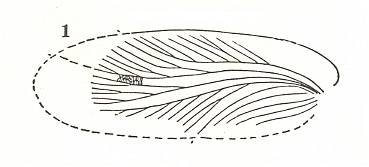
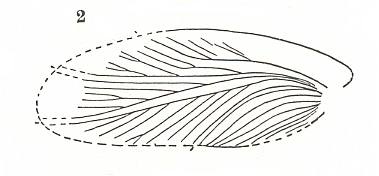
|
Frame 40 :
Phyloblatta Hauptiana SCHLECHTENDAL
Family Archimylacridae.
Length of fragment (upper and lower image) about 16 and 20 mm respectively.
Locality : Wettin in Sachsen.
Stratum : Ottweiler Stufe, upper Upper-Carboniferous.
(After HANDLIRSCH, 1906, description p.218)
Because HANDLIRSCH speaks about "the original specimen in Halle", both figures will refer to the same (biological) individual, i.e. its reverse and obverse impression.
|
Frame 41 :
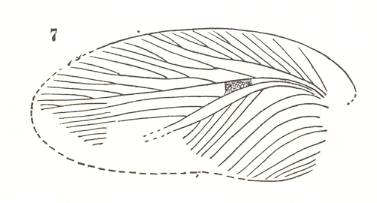
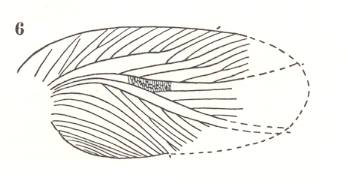
|
Frame 41 :
Phyloblatta corrugata SCHLECHTENDAL
Family Archimylacridae.
Length of tegmen, upper image, about 20 mm. Length of fragment, lower image, about 17 mm.
Locality : Wettin in Sachsen.
Stratum : Ottweiler Stufe, upper Upper-Carboniferous.
(After HANDLIRSCH, 1906, Taf.XXIII, fig 7 and 6, description p.219)
Two specimens.
|
Frame 42 :
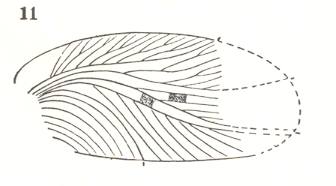
|
Frame 42 :
Phyloblatta manca SCHLECHTENDAL
Family Archimylacridae.
Length of fragment about 16 mm.
Locality : Löbejün in Sachsen.
Stratum : Ottweiler Stufe, upper Upper-Carboniferous.
(After HANDLIRSCH, 1906, Taf.XXIII, fig.11, description p.220)
|
Frame 43 :
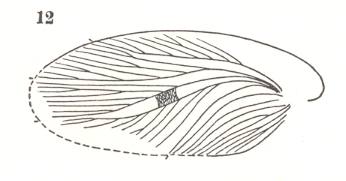
|
Frame 43 :
Phyloblatta misera SCHLECHTENDAL
Family Archimylacridae.
Length of tegmen about 18 mm.
Locality : Löbejün in Sachsen.
Stratum : Ottweiler Stufe, upper Upper-Carboniferous.
(After HANDLIRSCH, 1906, Taf.XXIII, fig.12 description p.220)
|
Frame 44 :
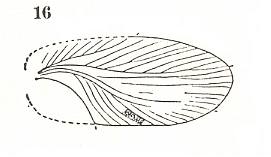
|
Frame 44 :
Phyloblatta mutila SCHLECHTENDAL
Family Archimylacridae.
Length of tegmen about 15 mm.
Locality : Löbejün in Sachsen.
Stratum : Ottweiler Stufe, upper Upper-Carboniferous.
(After HANDLIRSCH, 1906, Taf.XXIII, fig.16, description p.221)
|
Frame 45 :
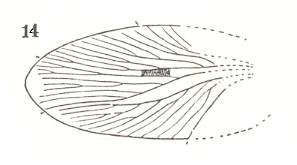
|
Frame 45 :
Phyloblatta Handlirschiana SCHLECHTENDAL
Family Archimylacridae.
Length of fragment about 14 mm.
Locality : Wettin in Sachsen.
Stratum : Ottweiler Stufe, upper Upper-Carboniferous.
(After HANDLIRSCH, 1906, Taf.XXIII, fig.14, description p.221)
|
Frame 46 :
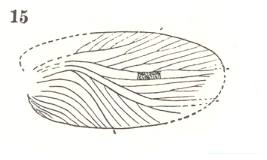
|
Frame 46 :
Phyloblatta blanda SCHLECHTENDAL
Family Archimylacridae.
Length of tegmen about 14 mm.
Locality : Wettin in Sachsen.
Stratum : Ottweiler Stufe, upper Upper-Carboniferous.
(After HANDLIRSCH, 1906, Taf.XXIII, fig.15, description p.221)
|
Frame 47 :
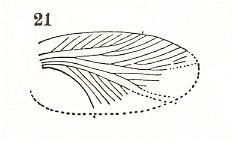
|
Frame 47 :
Phyloblatta sp. SCHLECHTENDAL
Family Archimylacridae.
Length of fragment about 11 mm.
Locality : Wettin in Sachsen.
Stratum : Ottweiler Stufe, upper Upper-Carboniferous.
(After HANDLIRSCH, 1906, Taf.XXIII, fig.21, description p.223)
This form, apparently, had still to be named by SCHLECHTENDAL. At the time, the latter was still investigating the Wettin-Löbejün fossil fauna (insects and spiders), and had sent original specimens to HANDLIRSCH.
|
Frame 48 :
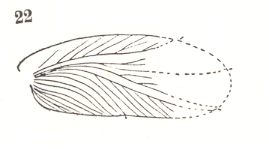
|
Frame 48 :
Phyloblatta venusta SCHLECHTENDAL
Family Archimylacridae.
Length of fragment about 12 mm.
Locality : Plötz in Sachsen.
Stratum : Ottweiler Stufe, upper Upper-Carboniferous.
(After HANDLIRSCH, 1906, Taf.XXIII, fig.22, description p.223)
|
Frame 49 :
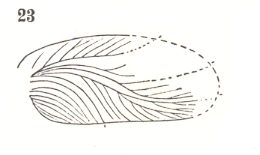
|
Frame 49 :
Phyloblatta levis SCHLECHTENDAL
Family Archimylacridae.
Length of fragment about 11 mm.
Locality : Wettin in Sachsen.
Stratum : Ottweiler Stufe, upper Upper-Carboniferous.
(After HANDLIRSCH, 1906, Taf.XXIII, fig.23, description p.223)
|
Frame 50 :
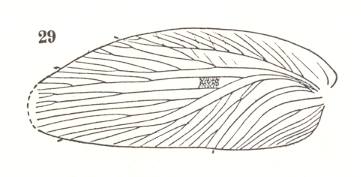
|
Frame 50 :
Phyloblatta monstruosa SCHLECHTENDAL
Family Archimylacridae.
Length of tegmen about 21 mm.
Locality : Wettin in Sachsen.
Stratum : Ottweiler Stufe,upper Upper-Carboniferous.
(After HANDLIRSCH, 1906, Taf.XXIII, Fig.29, description p.224)
|
The fossils depicted in the figures 30, 34, and 35 (in HANDLIRSCH 1906, and reproduced here) are, according to HANDLIRSCH too incomplete to be described in more detail. Some of them may coincide with already-named forms (or with ones still-to-be-named in what follows).
Frame 51 :
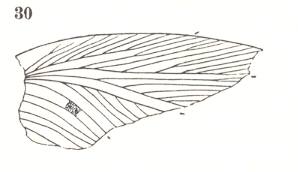
|
Frame 51 :
Phyloblatta assimilis SCHLECHTENDAL
Family Archimylacridae.
Length of fragment about 16 mm.
Locality : Wettin in Sachsen.
Stratum : Ottweiler Stufe, upper Upper-Carboniferous.
(After HANDLIRSCH, 1906, Taf.XXIII, fig.30, description p.225)
|
Frame 52 :
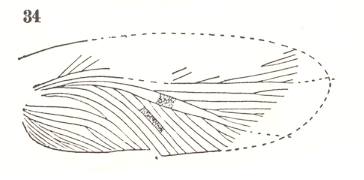
|
Frame 52 :
Phyloblatta generosa SCHLECHTENDAL
Family Archimylacridae.
Length of fragment about 20 mm.
Locality : Wettin in Sachsen.
Stratum : Ottweiler Stufe, upper Upper-Carboniferous.
(After HANDLIRSCH, 1906, Taf.XXIII, Fig.34, description p.226)
|
Frame 53 :
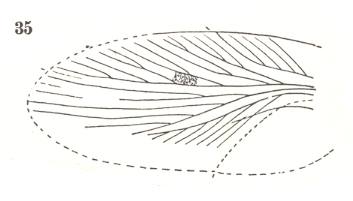
|
Frame 53 :
Phyloblatta Martiusana SCHLECHTENDAL
Family Archimylacridae.
Length of fragment about 20 mm.
Locality : ? Wettin in Sachsen.
Stratum : Ottweiler Stufe, upper Upper-Carboniferous.
(After HANDLIRSCH, 1906, Taf.XXIII, Fig.35, description p.226)
|
Frame 54 :
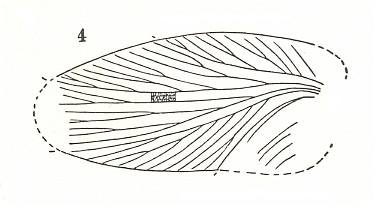
|
Frame 54 :
Phyloblatta curta SCHLECHTENDAL
Family Archimylacridae.
Length of fragment about 21 mm.
Locality : Wettin in Sachsen.
Stratum : Ottweiler Stufe, upper Upper-Carboniferous.
(After HANDLIRSCH, 1906, Taf.XXIII, fig.4, description p.219)
|
Frame 55 :
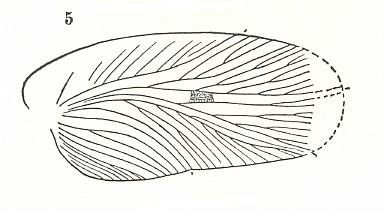
|
Frame 55 :
Phyloblatta Credneriana SCHLECHTENDAL
Family Archimylacridae.
Length of tegmen about 22 mm.
Locality : Löbejün in Sachsen.
Stratum : Ottweiler Stufe, upper Upper-Carboniferous.
(After HANDLIRSCH, 1906, Taf.XXIII, fig.5, description p.219)
|
Frame 56 :
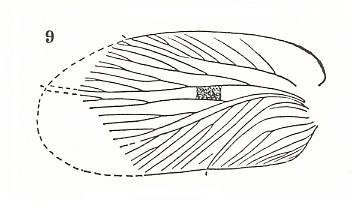
|
Frame 56 :
Phyloblatta solida SCHLECHTENDAL
Family Archimylacridae.
Length of fragment about 17 mm.
Locality : Wettin in Sachsen.
Stratum : Ottweiler Stufe, upper Upper-Carboniferous.
(After HANDLIRSCH, 1906, Taf.XXIII, fig.9, description p.219)
|
Frame 57 :
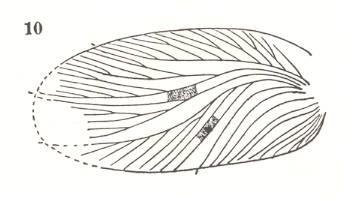
|
Frame 57 :
Phyloblatta striolata SCHLECHTENDAL
Family Archimylacridae.
Length of tegmen about 18 mm.
Locality : Wettin in Sachsen.
Stratum : Ottweiler Stufe, upper Upper-Carboniferous.
(After HANDLIRSCH, 1906, Taf.XXIII, fig.10, description p.220)
|
Frame 58 :
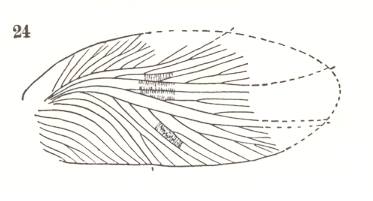
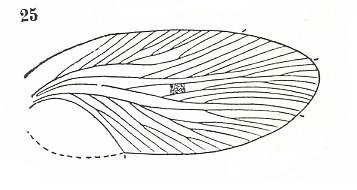
|
Frame 58 :
Phyloblatta lenta SCHLECHTENDAL
Family Archimylacridae.
Length of fragment, upper image, about 17 mm. Length of tegmen, lower image 21 mm
Locality : Wettin in Sachsen.
Stratum : Ottweiler Stufe, upper Upper-Carboniferous.
Two specimens.
(After HANDLIRSCH, 1906, Taf.XXIII, fig.24 and 25, description p.223)
|
Frame 59 :
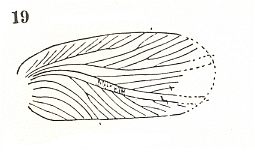
|
Frame 59 :
Phyloblatta nana HANDLIRSCH
Family Archimylacridae.
Length of tegmen about 13 mm.
Locality : Löbejün in Sachsen.
Stratum : Ottweiler Stufe, upper Upper-Carboniferous.
(After HANDLIRSCH, 1906, Taf.XXIII, fig.19, description p.222)
|
Frame 60 :
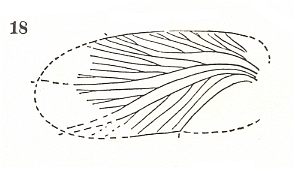
|
Frame 60 :
Phyloblatta sp. (SCHLECHTENDAL)
Family Archimylacridae.
Length of fragment about 13 mm.
Locality : Wettin in Sachsen.
Stratum : Ottweiler Stufe, upper Upper-Carboniferous.
(After HANDLIRSCH, 1906, Taf.XXIII, fig.18, description p.222)
|
Frame 61 :
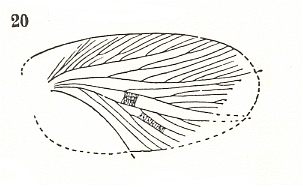
|
Frame 61 :
Phyloblatta Fritschiana SCHLECHTENDAL
Family Archimylacridae.
Length of tegmen about 15 mm.
Locality : Wettin in Sachsen.
Stratum : Ottweiler Stufe, upper Upper-Carboniferous.
(After HANDLIRSCH, 1906, Taf.XXIII, fig.20, description p.222)
|
Frame 62 :
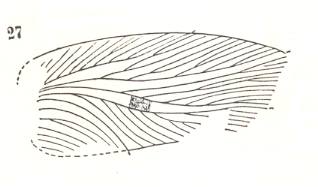
|
Frame 62 :
Phyloblatta amabilis SCHLECHTENDAL
Family Archimylacridae.
Length of fragment about 18 mm.
Locality : Wettin in Sachsen.
Stratum : Ottweiler Stufe, upper Upper-Carboniferous.
(After HANDLIRSCH, 1906, Taf.XXIII, fig.27, description p.224)
|
Frame 63 :
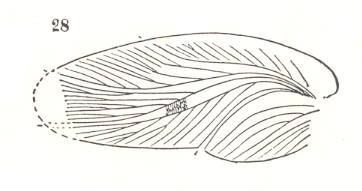
|
Frame 63 :
Phyloblatta fera SCHLECHTENDAL
Family Archimylacridae.
Length of tegmen about 19 mm.
Locality : Löbejün in Sachsen.
Stratum : Ottweiler Stufe, upper Upper-Carboniferous.
(After HANDLIRSCH, 1906, Taf.XXIII, fig.28, description p.224)
|
The fossils depicted in figures 32, 33, 43, and 45 (in HANDLIRSCH 1906, and here reproduced below) are, according to HANDLIRSCH preserved too incompletely to be described in more detail. Some of them may be conspecific with forms given earlier.
Frame 64 :
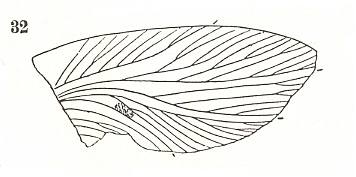
|
Frame 64 :
Phyloblatta regia SCHLECHTENDAL
Family Archimylacridae.
Length of fragment about 19 mm.
Locality : Wettin in Sachsen.
Stratum : Ottweiler Stufe, upper Upper-Carboniferous.
(After HANDLIRSCH, 1906, Taf.XXIII, fig.32, description p.225)
|
Frame 65 :
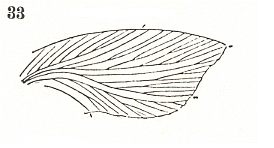
|
Frame 65 :
Phyloblatta Berlichiana SCHLECHTENDAL
Family Archimylacridae.
Length of fragment about 15 mm.
Locality : Dölau in Sachsen.
Stratum : Ottweiler Stufe, upper Upper-Carboniferous.
(After HANDLIRSCH, 1906, Taf.XXIII, fig.33, description p.225)
|
Frame 66 :
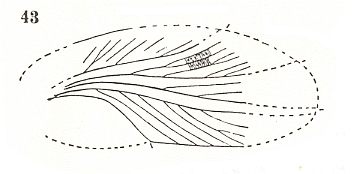
|
Frame 66 :
Phyloblatta ignota SCHLECHTENDAL
Family Archimylacridae.
Length of fragment about 13 mm.
Locality : Wettin in Sachsen.
Stratum : Ottweiler Stufe, upper Upper-Carboniferous.
(After HANDLIRSCH, 1906, Taf.XXIII, fig.43, description p.227)
|
Frame 67 :
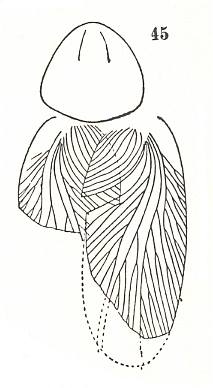 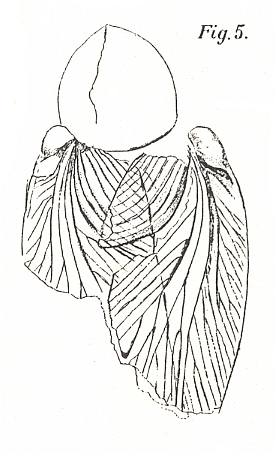
|
Frame 67 :
Phyloblatta carbonaria GERMAR
Family Archimylacridae.
Length of fragment of right tegmen presumable about 17 mm.
Locality : Wettin in Sachsen.
Stratum : Ottweiler Stufe,
upper Upper-Carboniferous.
Both images of the same specimen.
(Left image after HANDLIRSCH, 1906, Taf.XXIII, fig.45, description p.228)
(Right image after SCHLECHTENDAL, 1912, Tab. V, fig.5)
(See also SCHLECHTENDAL, 1912, p.25)
|
The next figures depict still more Blattida from the Wettiner basin, that is, figures reproduced from Tafel XXIV in HANDLIRSCH, 1906.
The figures 1 and 2 of that Tafel represent fossils too fragmentary to deal with any further.
Frame 68 :
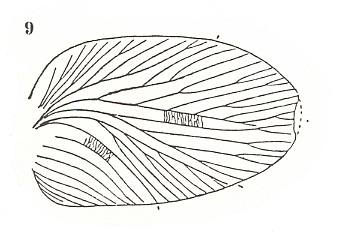
|
Frame 68 :
Cardioblatta Fritschi SCHLECHTENDAL
Family Mylacridae.
Length of tegmen about 16 mm.
Locality : Wettin in Sachsen.
Stratum : Ottweiler Stufe, upper Upper-Carboniferous.
(After HANDLIRSCH, 1906, Taf.XXIV, fig.9, description p.231)
|
Xenoblatta mendica SCHLECHTENDAL
Locality : Wettin in Sachsen.
Stratum : Ottweiler Stufe, upper Upper-Carboniferous.
The figure in HANDLIRSCH, Taf.XXIV, is too defective to reproduce here as a result of bookbinding.
Description in HANDLIRSCH, 1906, p.232.
Frame 69 :
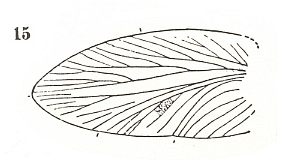
|
Frame 69 :
Sphaleroblattina ingens SCHLECHTENDAL
Family : Archimylacridae or Poroblattinidae.
Length of tegmen about 10 mm.
Locality : Wettin in Sachsen.
Stratum : Ottweiler Stufe,
upper Upper-Carboniferous.
(After HANDLIRSCH, 1906, Taf.XXIV, fig.15, description p.234)
|
Frame 70 :
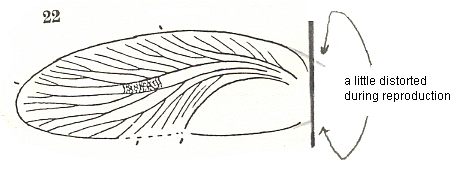
|
Frame 70 :
Drepanoblattina plicata SCHLECHTENDAL
Family Archimylacridae.
Length of tegmen about 9 mm.
Locality : Wettin in Sachsen.
Stratum : Ottweiler Stufe,
upper Upper-Carboniferous.
(After HANDLIRSCH, 1906, Taf.XXIV, fig.22, description p.236)
|
The figures 38, 39, 40, 41, and 42 in HANDLIRSCH's Tafel XXIV depict fossils too fragmentary to deal with properly.
Next we continue to give fossil Blattida from the Wettiner basin as drawn in Tafel XXV in HANDLIRSCH 1906.
The following figures of this table are, as a result of bookbinding, too defective to be reproduced here : 7. 16, and 21. The last one will be listed though.
And the following figures in that Tafel will not be considered here at all because the fossils represented by them are too fragmentary to adequately deal with : 23, 24, 29, 30, 28, 31, 27, 32, 13, and 17.
Sysciophlebia signata SCHLECHTENDAL
Family Spiloblattinidae.
Figure 21 in Taf.XXV in HANDLIRSCH 1906. Not here reproduced.
Locality : Wettin in Sachsen.
Stratum : Ottweiler Stufe, upper Upper-Carboniferous.
HANDLIRSCH, 1906, description p.243
Frame 71 :
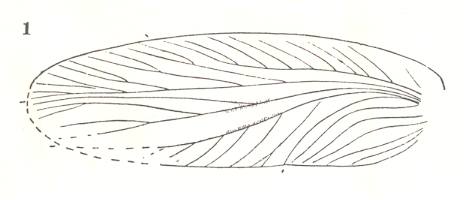
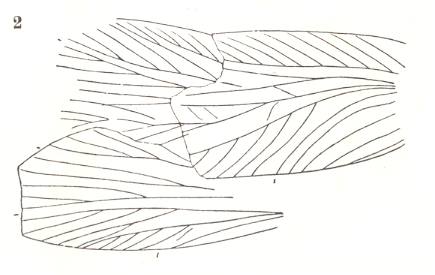
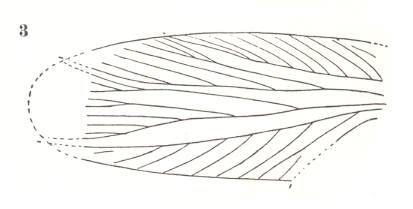
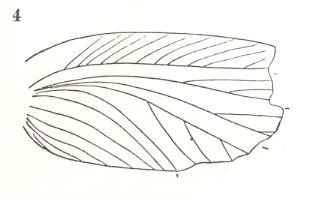
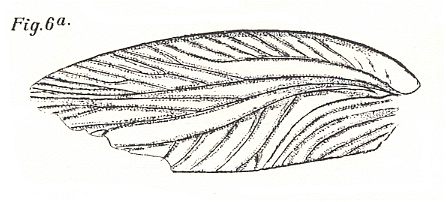
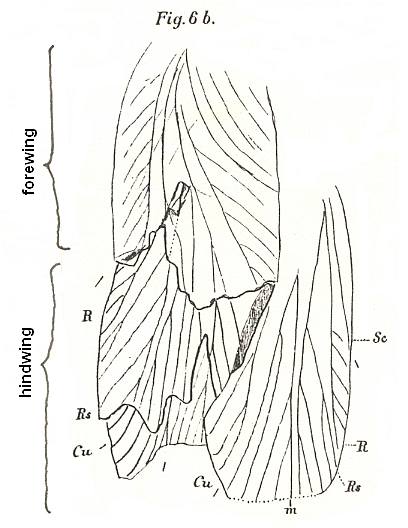
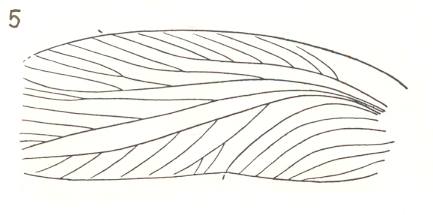
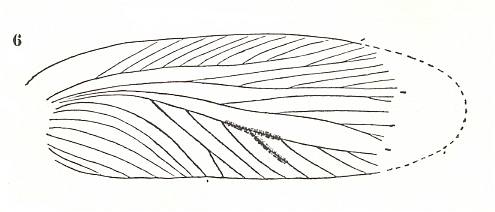
|
Frame 71 :
Sysciophlebia euglyptica GERMAR
(Figures 1, 2, 3, 4, 6a, 6b, 5, 6)
Family Spiloblattinidae.
Locality : Wettin and Löbejün in Sachsen.
Stratum : Ottweiler Stufe,
upper Upper-Carboniferous.
Seven specimens of this species depicted. Figures 2 and 6b are of the same specimen.
Fig 1 : Length of tegmen about 32 mm.
Fig 2 : Length of fossil about 30 mm.
Fig 3 : Length of fragment about 20 mm.
Fig 4 : Length of fragment about 19 mm.
Fig 6a : Length of fragment about 30 mm.
Fig 5 : Length of fragment about 27 mm.
Fig 6 : Length of fragment about 25 mm.
(Fig. 1, 2, 3, 4, 5, and 6 after HANDLIRSCH, 1906, Taf.XXV, description p.240)
(Fig 6a and 6b after SCHLECHTENDAL, 1912, Tab.V, fig,6a, 6b)
See also SCHLECHTENDAL, 1912, p.27, 28-31.
|
Frame 72 :
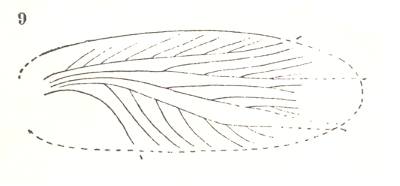
|
Frame 72 :
Sysciophlebia elongata SCHLECHTENDAL
Family Spiloblattinidae.
Length of fragment about 25 mm.
Locality : Wettin in Sachsen.
Stratum : Ottweiler Stufe,
upper Upper-Carboniferous.
(After HANDLIRSCH, 1906, Taf.XXV, fig.9, description p.241)
|
Frame 73 :
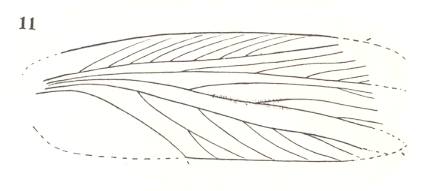
|
Frame 73 :
Sysciophlebia Martiusana SCHLECHTENDAL
Family Spiloblattinidae.
Length of fragment about 26 mm.
Locality : Gröbzig near Löbejün in Sachsen.
Stratum : Ottweiler Stufe,
upper Upper-Carboniferous.
(After HANDLIRSCH, 1906, Taf.XXV, fig.11, description p.241)
|
Frame 74 :
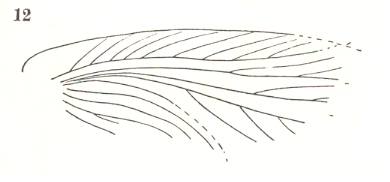
|
Frame 74 :
Sysciophlebia angustipennis SCHLECHTENDAL
Family Spiloblattinidae.
Length of fragment about 21 mm.
Locality : Wettin in Sachsen.
Stratum : Ottweiler Stufe,
upper Upper-Carboniferous.
(After HANDLIRSCH, 1906, Taf.XXV, fig.12, description p.242)
|
Frame 75 :
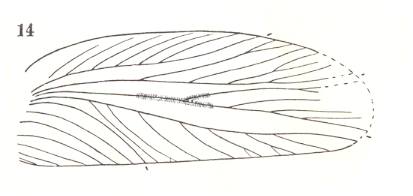
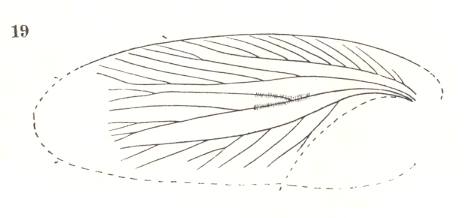
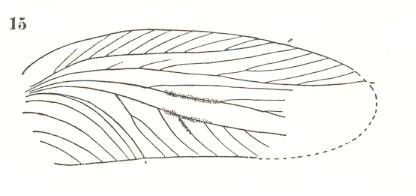
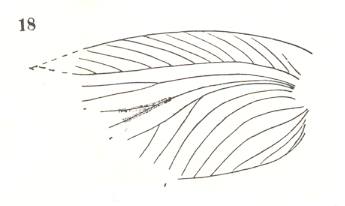
|
Frame 75 :
Sysciophlebia agilis SCHLECHTENDAL
Family Spiloblattinidae.
Locality : Wettin and Löbejün in Sachsen.
Stratum : Ottweiler Stufe,
upper Upper-Carboniferous.
Four specimens.
(Figure 14, 19, 15, 18 after HANDLIRSCH, 1906, Taf.XXV, description p.242)
(As to figure 18, HANDLIRSCH places a question-mark at 'agilis' ).
( Figure 16 in Taf.XXV was unfit for reproduction.)
Fig 14 : Length of tegmen about 23 mm.
Fig 19 : Length of fragment about 23 mm.
Fig 15 : Length of tegmen about 24 mm.
Fig 18 : Length of fragment about 15 mm.
|
Frame 76 :
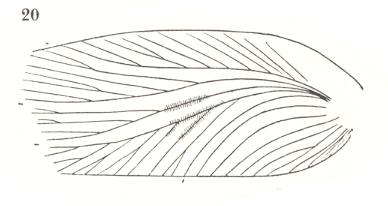
|
Frame 76 :
Sysciophlebia nobilis SCHLECHTENDAL
Family Spiloblattinidae.
Length of fragment about 21 mm.
Locality : Wettin in Sachsen.
Stratum : Ottweiler Stufe,
upper Upper-Carboniferous.
(After HANDLIRSCH, 1906, Taf.XXV, fig.20, description p.242)
|
Frame 77 :
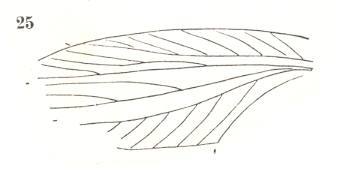
|
Frame 77 :
Sysciophlebia oligoneura HANDLIRSCH
Family Spiloblattinidae.
Length of fragment about 21 mm.
Locality : Löbejün in Sachsen.
Stratum : Ottweiler Stufe,
upper Upper-Carboniferous.
(After HANDLIRSCH, 1906, Taf.XXV, fig.25, description p.244)
|
Frame 78 :
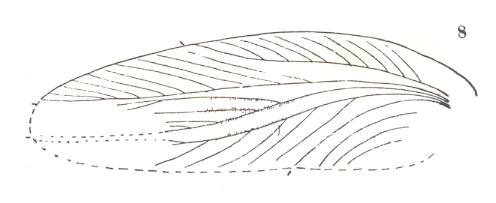
|
Frame 78 :
Sysciophlebia Huysseni SCHLECHTENDAL
Family Spiloblattinidae.
Length of tegmen about 31 mm.
Locality : Löbejün in Sachsen.
Stratum : Ottweiler Stufe,
upper Upper-Carboniferous.
(After HANDLIRSCH, 1906, Taf.XXV, fig.8, description p.241)
|
Frame 79 :
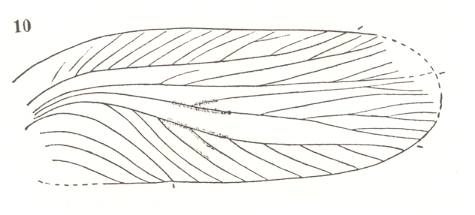
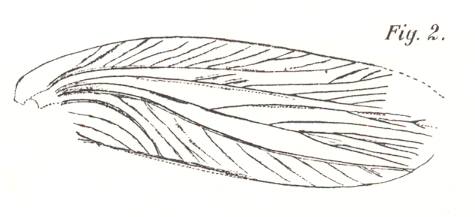
|
Frame 79 :
Sysciophlebia producta SCUDDER
(In HANDLIRSCH 1906 we read : " Sysciophlebia sp. SCHLECHTENDAL", but it must be S. producta [SCHLECHTENDAL, 1912, p.80. But the page reference given by SCHLECHTENDAL must be p.241, instead of p.255 ] )
Family Spiloblattinidae.
Length of preserved tegmen about 29 mm, total length at least 36 mm.
Locality : Löbejün in Sachsen.
Stratum : Ottweiler Stufe,
upper Upper-Carboniferous.
(Upper image after HANDLIRSCH, 1906, Taf.XXV, fig.10, description p.241)
(Lower image after SCHLECHTENDAL, 1912, Tab.VII, fig.2. According to SCHLECHTENDAL, 1912, p.83/4 the hind margin (in his terminology the 'interior margin') of the wing is folded back.)
( See SCHLECHTENDAL, 1912, p.83 and pp.78 )
|
Frame 80 :
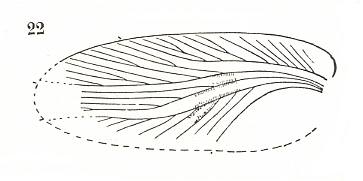
|
Frame 80 :
Sysciophlebia tenera SCHLECHTENDAL
Family Spiloblattinidae.
Length of tegmen about 21 mm.
Locality : Wettin in Sachsen.
Stratum : Ottweiler Stufe,
upper Upper-Carboniferous.
(After HANDLIRSCH, 1906, Taf.XXV, fig.22, description p.243)
|
Frame 81 :
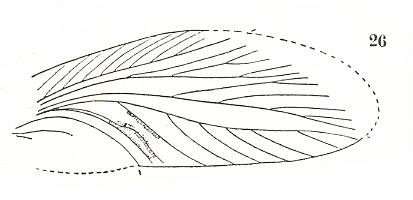
|
Frame 81 :
Sysciophlebia elegantissima SCHLECHTENDAL
Family Spiloblattinidae.
Length of fragment about 23 mm.
Locality : Wettin in Sachsen.
Stratum : Ottweiler Stufe,
upper Upper-Carboniferous.
(After HANDLIRSCH, 1906, Taf.XXV, fig.26, description p.244)
|
Frame 82 :
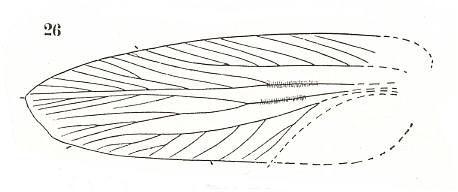
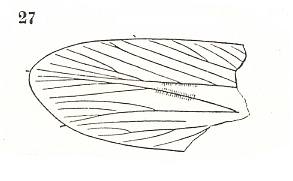
|
Frame 82 :
Dicladoblatta subtilis SCHLECHTENDAL
Family Spiloblattinidae.
Length of fragment (upper image) about 24 mm, that of lower image 15 mm.
Locality : Wettin in Sachsen.
Stratum : Ottweiler Stufe,
upper Upper-Carboniferous.
Two specimens.
(After HANDLIRSCH, 1906, Taf.XXVI, fig.26 and 27, description p.252)
|
Figure 28 in HANDLIRSCH's Tafel XXVI, is about too fragmentary a fossil for us to deal with.
Frame 83 :
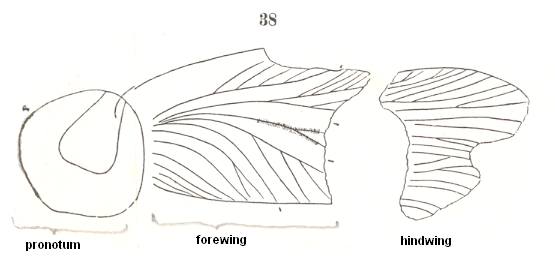
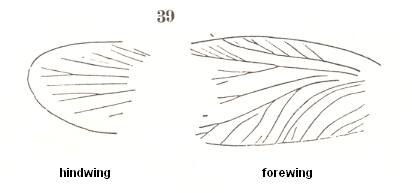
Comments
HANDLIRSCH, 1906, p.255, indicates as locality (where the fossil was found) "Wettin and Löbejün in Sachsen". In addition, he notes that the (rock-) impression depicted in fig. 39 (Taf.XXVI) (2nd image in frame 83) is very similar to the specimen of GOLDENBERG : but this is the counterpart of the impression depicted in Fig. 38 (1st image in frame 83), both found in Löbejün. See SCHLECHTENDAL, 1912, p.79 : Figure 8 in GOLDENBERG 1869 is : Syscioblatta Dohrni SCUDDER. Locality : according to the label pasted on both counterparts : "Insect aus dem Schrambergen des Oberflötzes Loebejün."
The original (specimen) of GOLDENBERG [In the script of Tafel XXVI HANDLIRSCH mistakenly notes with respect to figure 38 : GERMAR's original. See the text on page 255 in HANDLIRSCH himself, and SCHLECHTENDAL, 1912, p.79.] :
Kgl. mineralog. Museum Dresden. Hochdruck Blattina euglyptica GERMAR Nr.1.
Counterpart of it : Kgl. geolog. Institut Breslau. Hohldruck (Runge 1867) without pronotum [And thus corresponding to Fig.39 of Tafel XXVI in HANDLIRSCH, and reproduced here as second image of frame 83.]
The counterpart depicted in Tafel XXVI, fig. 38 (and reproduced here as first image of frame 83) was determined by GOLDENBERG as belonging to the earlier described species Blattina euglyptica GERMAR.
This piece (together with its counterpart of the Kgl. geolog. Inst. Breslau) is later determined as to belong to the species Syscioblatta Dohrni SCUDDER.
The pronotum, in fig.38 of Taf. XXVI in HANDLIRSCH (first image, frame 83), does not lie in its natural position, but transversely with its front end to the right (i.e. in the figure upwards).
See also the drawings made by SCHLECHTENDAL, 1912, as they are reproduced here as the third image in frame 83 :
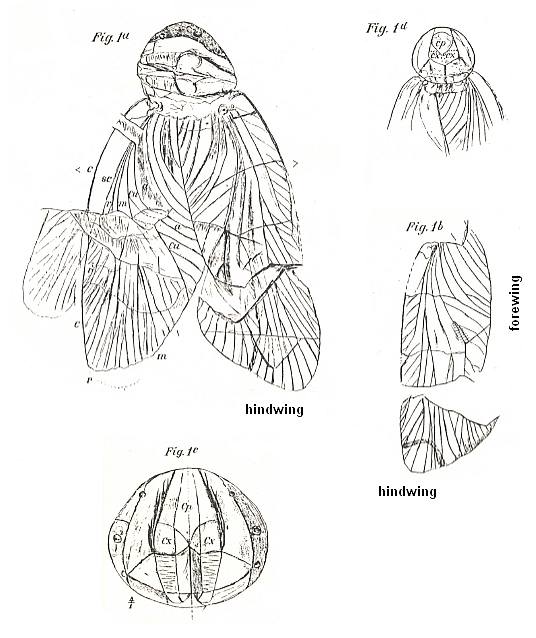
Subscript of image
Fig. 1a-d :
Syscioblatta Dohrni SCUDDER, Mus. Dresden and Breslau.
a, c Mus. Dresden. b : Breslau.
1a [upper left image] : Afterwards somewhat more cleared (from rock fragments obscuring the fossil) original specimen of GOLDENBERG. All four wings more or less visible, as well as the mesonotum (second thoracic dorsal shield) with the roots of the forewings, and the transversely positioned pronotum.
1c [bottom image] : The pronotum more strongly magnified. cp = 'head-groove', cx = grooves (places of attachement) of the front coxae ['hips' of forelegs].
1d [upper right image] : The pronotum restored in its natural orientation with respect to the wings.
1b [lower right image] : Right forewing (tegmen) in concave-print of the counterpart, Mus. Breslau [+ part of hind wing].
Same specimen as in fig. 39 (HANDLIRSCH, Taf. XXVI) (second image in frame 83).
(After SCHLECHTENDAL, 1912, Tab.VII, fig.1a-d)
See also SCHLECHTENDAL, 1912, p.81 and pp.78.
|
Frame 83 :
Syscioblatta dohrni SCUDDER
Family Spiloblattinidae.
Length of fossil about 31 mm.
Locality : Löbejün in Sachsen.
Stratum : Ottweiler Stufe,
upper Upper-Carboniferous.
(Upper two images after HANDLIRSCH, 1906, Taf.XXVI, fig.38 and 39, description p.255)
(Bottom image after SCHLECHTENDAL, 1912, Tab. VII, fig. 1a-d)
(See also SCHLECHTENDAL, 1912, p.81 and pp.78)
|
The fossils indicated by HANDLIRSCH 1906 as "incertae sedis" (fossils that are impossible to determine) will not be considered here. The Spiloblattinidae incertae sedis are to be found in HANDLIRSCH, 1906, p.257/8.
Frame 84 :
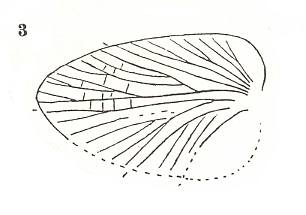
|
Frame 84 :
Pseudomylacris wettinensis SCHLECHTENDAL
Family Mylacridae.
Length of tegmen 7 mm.
Locality : Wettin in Sachsen.
Stratum : Ottweiler Stufe, upper Upper-Carboniferous.
(After HANDLIRSCH, 1906, Taf.XXIX, fig.3, description p.275)
See also Cardioblatta in frame 68 above.
|
Frame 85 :
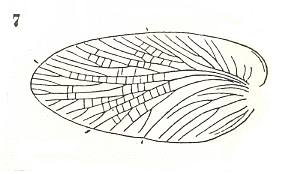
|
Frame 85 :
Mylacridium Fritschi SCHLECHTENDAL
Family Mylacridae.
Length of tegmen 9 mm.
Locality : Wettin in Sachsen.
Stratum : Ottweiler Stufe, upper Upper-Carboniferous.
(After HANDLIRSCH, 1906, Taf.XXIX, fig.7, description p.276)
|
Frame 86 :
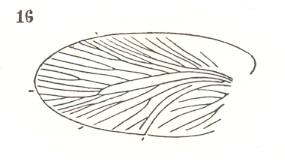
|
Frame 86 :
Mylacridium pulcrum SCHLECHTENDAL
Family Mylacridae.
Length of tegmen 8.5 mm.
Locality : Wettin in Sachsen.
Stratum : Ottweiler Stufe, upper Upper-Carboniferous.
(After HANDLIRSCH, 1906, Taf.XXIX, fig.16, description p.279)
|
Frame 87 :
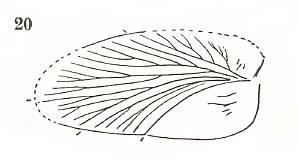
|
Frame 87 :
? Mylacridium gracile SCHLECHTENDAL
Family Mylacridae.
Length of tegmen about 9 mm.
Locality : Wettin in Sachsen.
Stratum : Ottweiler Stufe, upper Upper-Carboniferous.
(After HANDLIRSCH, 1906, Taf.XXIX, fig.20, description p.279)
|
Frame 88 :

|
Frame 88 :
Mylacridium superbum SCHLECHTENDAL
Family Mylacridae.
Length of tegmen about 8.5 mm.
Locality : Wettin in Sachsen.
Stratum : Ottweiler Stufe, upper Upper-Carboniferous.
(After HANDLIRSCH, 1906, Taf.XXIX, fig.13, description p.278)
|
Frame 89 :
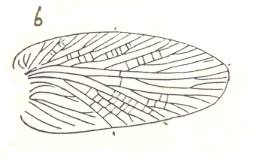
|
Frame 89 :
Mylacridium handlirschi SCHLECHTENDAL
Family Mylacridae.
Length of tegmen 8 mm.
Locality : Wettin in Sachsen.
Stratum : Ottweiler Stufe, upper Upper-Carboniferous.
(After HANDLIRSCH, 1906, Taf.XXIX, fig.6, description p.276)
|
Frame 90 :
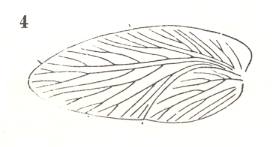
|
Frame 90 :
Mylacridium germari SCHLECHTENDAL
Family Mylacridae.
Length of tegmen 9.5 mm.
Locality : Wettin in Sachsen.
Stratum : Ottweiler Stufe, upper Upper-Carboniferous.
(After HANDLIRSCH, 1906, Taf.XXIX, fig.4, description p.276)
|
Frame 91 :
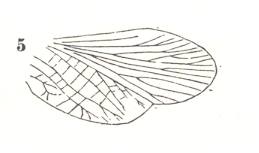
|
Frame 91 :
Mylacridium germari SCHLECHTENDAL
Family Mylacridae.
Length of hind-wing 9 mm.
Locality : Wettin in Sachsen.
Stratum : Ottweiler Stufe, upper Upper-Carboniferous.
(After HANDLIRSCH, 1906, Taf.XXIX, fig.5, description p.276)
|
Frame 92 :
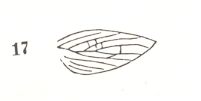
|
Frame 92 :
Mylacridium Berlichianum SCHLECHTENDAL
Isolated anal field (clavus) of a Mylacridium forewing.
Family Mylacridae.
Length of clavus 4.5 mm.
Locality : Wettin in Sachsen.
Stratum : Ottweiler Stufe, upper Upper-Carboniferous.
(After HANDLIRSCH, 1906, Taf.XXIX, fig.17, description p.279)
|
Frame 93 :
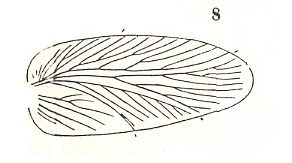
|
Frame 93 :
Mylacridium Schröteri SCHLECHTENDAL
Family Mylacridae.
Length of tegmen 9.5 mm.
Locality : Löbejün in Sachsen.
Stratum : Ottweiler Stufe, upper Upper-Carboniferous.
(After HANDLIRSCH, 1906, Taf.XXIX, fig.8, description p.277)
|
Frame 94 :
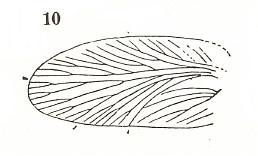
|
Frame 94 :
Mylacridium longulum SCHLECHTENDAL
Family Mylacridae.
Length of tegmen 7 mm.
Locality : Wettin in Sachsen.
Stratum : Ottweiler Stufe, upper Upper-Carboniferous.
(After HANDLIRSCH, 1906, Taf.XXIX, fig.10, description p.277)
|
Frame 95 :
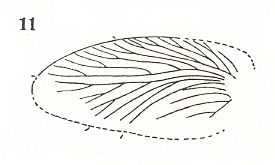
|
Frame 95 :
Mylacridium Goldenbergi SCHLECHTENDAL
Family Mylacridae.
Length of tegmen about 7.5 mm.
Locality : Wettin in Sachsen.
Stratum : Ottweiler Stufe, upper Upper-Carboniferous.
(After HANDLIRSCH, 1906, Taf.XXIX, fig.11, description p.277)
|
Frame 96 :
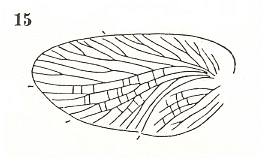
|
Frame 96 :
Mylacridium Brongniarti SCHLECHTENDAL
Family Mylacridae.
Length of tegmen 7.5 mm.
Locality : Wettin in Sachsen.
Stratum : Ottweiler Stufe, upper Upper-Carboniferous.
(After HANDLIRSCH, 1906, Taf.XXIX, fig.15, description p.278)
|
Frame 97 :
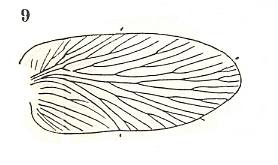
|
Frame 97 :
Mylacridium Berlichi SCHLECHTENDAL
Family Mylacridae.
Length of tegmen 9 mm.
Locality : Wettin in Sachsen.
Stratum : Ottweiler Stufe, upper Upper-Carboniferous.
(After HANDLIRSCH, 1906, Taf.XXIX, fig.9, description p.277)
|
Frame 98 :
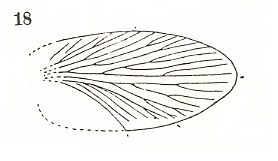
|
Frame 98 :
? Mylacridium incertum SCHLECHTENDAL
Family Mylacridae.
Length of tegmen (fragment) about 7 mm.
Locality : Wettin in Sachsen.
Stratum : Ottweiler Stufe, upper Upper-Carboniferous.
(After HANDLIRSCH, 1906, Taf.XXIX, fig.18, description p.279)
|
Frame 99 :
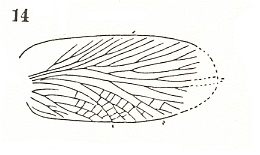
|
Frame 99 :
Mylacridium planum SCHLECHTENDAL
Family Mylacridae.
Length of tegmen (fragment) about 8 mm.
Locality : Wettin in Sachsen.
Stratum : Ottweiler Stufe, upper Upper-Carboniferous.
(After HANDLIRSCH, 1906, Taf.XXIX, fig.14, description p.278)
|
Frame 100 :
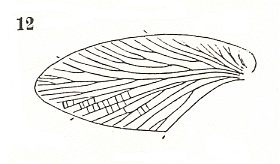
|
Frame 100 :
Mylacridium jucundum SCHLECHTENDAL
Family Mylacridae.
Length of tegmen 8.5 mm.
Locality : Wettin in Sachsen.
Stratum : Ottweiler Stufe, upper Upper-Carboniferous.
(After HANDLIRSCH, 1906, Taf.XXIX, fig.12, description p.278)
|
Frame 101 :
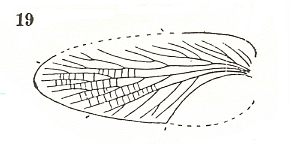
|
Frame 101 :
? Mylacridium depressum SCHLECHTENDAL
Family Mylacridae.
Length of tegmen 8.5 mm.
Locality : Wettin in Sachsen.
Stratum : Ottweiler Stufe, upper Upper-Carboniferous.
(After HANDLIRSCH, 1906, Taf.XXIX, fig.19, description p.279)
|
Frame 102 :
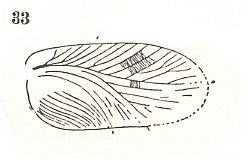
|
Frame 102 :
Poroblattina tenera SCHLECHTENDAL
Family Poroblattinidae.
Length of tegmen about 7 mm.
Locality : Wettin in Sachsen.
Stratum : Ottweiler Stufe, upper Upper-Carboniferous.
(After HANDLIRSCH, 1906, Taf.XXIX, fig.33, description p.285)
|
Frame 103 :
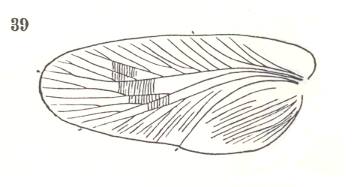
|
Frame 103 :
Poroblattina sp. SCHLECHTENDAL
Family Poroblattinidae.
Length of tegmen 10 mm.
Locality : Wettin in Sachsen.
Stratum : Ottweiler Stufe, upper Upper-Carboniferous.
(After HANDLIRSCH, 1906, Taf.XXIX, fig.39, description p.286)
|
Frame 104 :
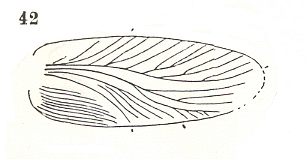
|
Frame 104 :
Poroblattina longula SCHLECHTENDAL
Family Poroblattinidae.
Length of tegmen 8 mm.
Locality : Wettin in Sachsen.
Stratum : Ottweiler Stufe, upper Upper-Carboniferous.
(After HANDLIRSCH, 1906, Taf.XXIX, fig.42, description p.286)
|
Frame 105 :
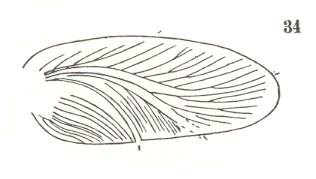
|
Frame 105 :
Poroblattina incerta SCHLECHTENDAL
Family Poroblattinidae.
Length of tegmen 8 mm.
Locality : Wettin in Sachsen.
Stratum : Ottweiler Stufe, upper Upper-Carboniferous.
(After HANDLIRSCH, 1906, Taf.XXIX, fig.34, description p.285)
|
Figure 38 in HANDLIRSCH, 1906, Taf. XXIX is not considered here, because the fossil is too fragmentary, and the locality uncertain.
Frame 106 :
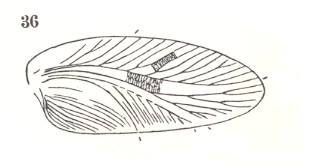
|
Frame 106 :
Poroblattina subtilis SCHLECHTENDAL
Family Poroblattinidae.
Length of tegmen 9 mm.
Locality : Wettin in Sachsen.
Stratum : Ottweiler Stufe,
upper Upper-Carboniferous.
(After HANDLIRSCH, 1906, Taf.XXIX, fig.36, description p.285)
|
Frame 107 :
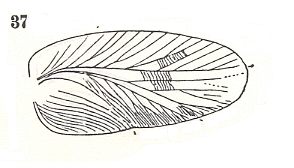
|
Frame 107 :
Poroblattina undosa SCHLECHTENDAL
Family Poroblattinidae.
Length of tegmen 8 mm.
Locality : Löbejün in Sachsen.
Stratum : Ottweiler Stufe,
upper Upper-Carboniferous.
(After HANDLIRSCH, 1906, Taf.XXIX, fig.37, description p.285)
|
Frame 108 :
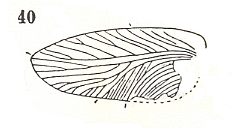
|
Frame 108 :
Poroblattina varia SCHLECHTENDAL
Family Poroblattinidae.
Length of tegmen 7 mm.
Locality : Wettin in Sachsen.
Stratum : Ottweiler Stufe,
upper Upper-Carboniferous.
(After HANDLIRSCH, 1906, Taf.XXIX, fig.40, description p.286)
|
Frame 109 :
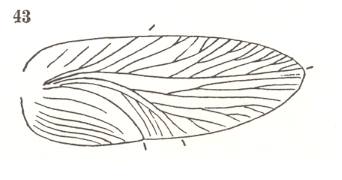
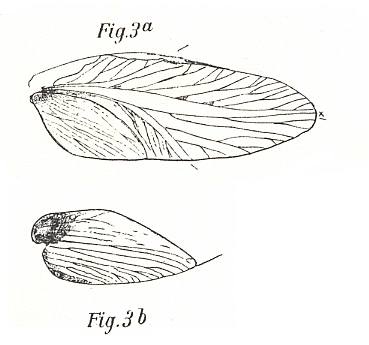
In HANDLIRSCH, 1906, p.287, the species is given by "Poroblattina virgulata SCHLECHTENDAL", but this name must give way to the Giebelian species name (see SCHLECHTENDAL, 1912, p.49)
Note the very contracted CuA.
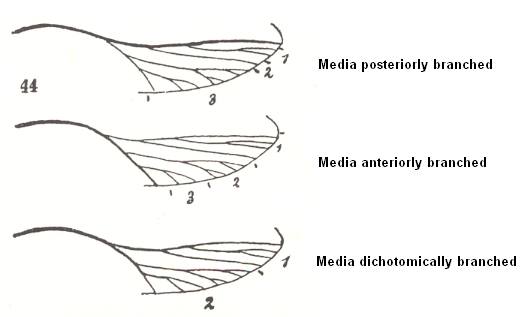
Image above :
Three different interpretations as to what is supposed to be the main trunk of the Media.
After HANDLIRSCH, 1906.
|
Frame 109 :
Poroblattina Germari GIEBEL
Family Poroblattinidae.
Length of tegmen 9 mm. Width 3.5 mm.
Locality : Löbejün in Sachsen.
Stratum : Ottweiler Stufe,
upper Upper-Carboniferous.
(Upper image after HANDLIRSCH, 1906, Taf.XXIX, fig.43, description p.287)
(Lower image, tegmen [fig.3a], and clavus a little more enlarged [fig.3b], after SCHLECHTENDAL, 1912, Tab.VI, Fig.3)
Upper and lower images presumably referring to the same specimen.
(See SCHLECHTENDAL, 1912, p.50 and p.49 )
|
Frame 110 :
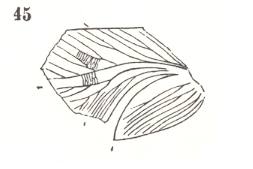
|
Frame 110 :
Poroblattina ambigua SCHLECHTENDAL
Family Poroblattinidae.
Length of fragment about 7 mm.
Locality : Wettin in Sachsen.
Stratum : Ottweiler Stufe, upper Upper-Carboniferous.
(After HANDLIRSCH, 1906, Taf.XXIX, fig.45, description p.287)
|
Frame 111 :
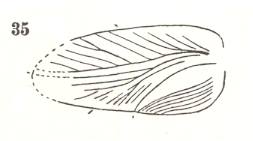
|
Frame 111 :
Poroblattina debilis SCHLECHTENDAL
Family Poroblattinidae.
Length of tegmen about 7 mm.
Locality : Wettin in Sachsen.
Stratum : Ottweiler Stufe, upper Upper-Carboniferous.
(After HANDLIRSCH, 1906, Taf.XXIX, fig.35, description p.285)
|
Frame 112 :
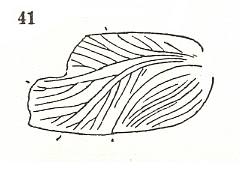
|
Frame 112 :
Poroblattina obscura SCHLECHTENDAL
Family Poroblattinidae.
Length of fragment about 8 mm.
Locality : Wettin in Sachsen.
Stratum : Ottweiler Stufe, upper Upper-Carboniferous.
(After HANDLIRSCH, 1906, Taf.XXIX, fig.41, description p.286)
|
Frame 113 :
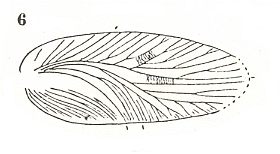
|
Frame 113 :
Autoblattina amoena SCHLECHTENDAL
Family Poroblattinidae.
Length of tegmen about 8.5 mm.
Locality : Wettin in Sachsen.
Stratum : Ottweiler Stufe, upper Upper-Carboniferous.
(After HANDLIRSCH, 1906, Taf.XXX, fig.6, description p.289)
|
Frame 114 :
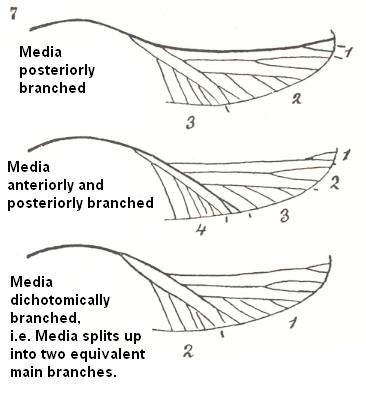
Image above : Interpretation of Media (after HANDLIRSCH, 1906)
|
Frame 115 :
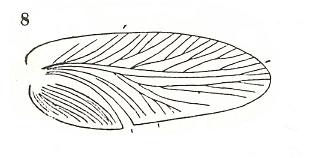
|
Frame 115 :
Autoblattina elegans SCHLECHTENDAL
Family Poroblattinidae.
Length of tegmen about 8.5 mm.
Locality : Wettin in Sachsen.
Stratum : Ottweiler Stufe, upper Upper-Carboniferous.
(After HANDLIRSCH, 1906, Taf.XXX, fig.8, description p.289)
|
Frame 116 :
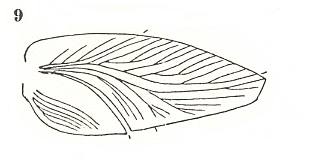
|
Frame 116 :
Autoblattina gracilis SCHLECHTENDAL
Family Poroblattinidae.
Length of tegmen about 9.5 mm.
Locality : Wettin in Sachsen.
Stratum : Ottweiler Stufe, upper Upper-Carboniferous.
(After HANDLIRSCH, 1906, Taf.XXX, fig.9, description p.289)
|
Frame 117 :
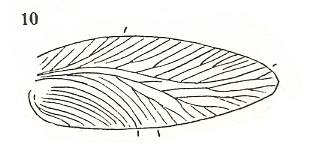
|
Frame 117 :
Autoblattina sp. SCHLECHTENDAL
Family Poroblattinidae.
Length of tegmen about 9.5 mm.
Locality : Löbejün in Sachsen.
Stratum : Ottweiler Stufe, upper Upper-Carboniferous.
(After HANDLIRSCH, 1906, Taf.XXX, fig.10, description p.289)
|
Frame 118 :
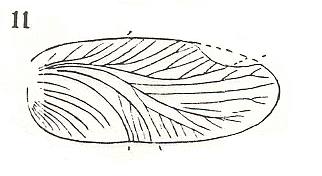
|
Frame 118 :
Autoblattina difficilis SCHLECHTENDAL
Family Poroblattinidae.
Length of tegmen about 8 mm.
Locality : Wettin in Sachsen.
Stratum : Ottweiler Stufe, upper Upper-Carboniferous.
(After HANDLIRSCH, 1906, Taf.XXX, fig.11, description p.289)
|
Frame 119 :
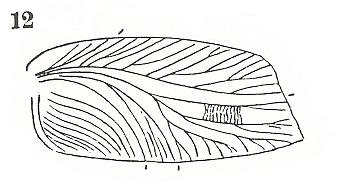
|
Frame 119 :
Autoblattina jucunda SCHLECHTENDAL
Family Poroblattinidae.
Length of fragment about 8 mm.
Locality : ? Wettin or Löbejün in Sachsen.
Stratum : Ottweiler Stufe, upper Upper-Carboniferous.
(After HANDLIRSCH, 1906, Taf.XXX, fig.12, description p.290)
|
Frame 120 :
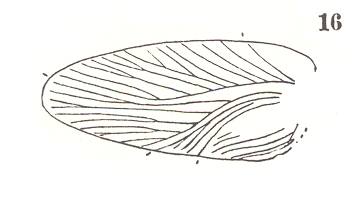
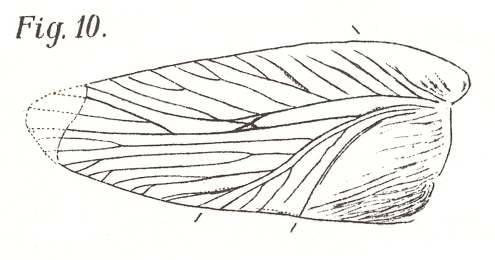
|
Frame 120 :
Nearoblatta parvula GOLDENBERG
Family Poroblattinidae.
Length of tegmen about 8.5 mm.
Locality : Löbejün in Sachsen.
Stratum : Ottweiler Stufe,
upper Upper-Carboniferous.
(Upper image after HANDLIRSCH, 1906, Taf.XXX, fig.16, description p.292)
(Bottom image after SCHLECHTENDAL, 1912, Tab.VI, fig.10)
Both drawings referring to same specimen.
SCHLECHTENDAL gives as locality : The upper-flötz at Löbejün.
(see SCHLECHTENDAL, 1912, p.71 and 70)
The table-subscript in SCHLECHTENDAL reads, with respect to the present species, "Nearoblattina" which must be "Nearoblatta".
|
Frame 121 :
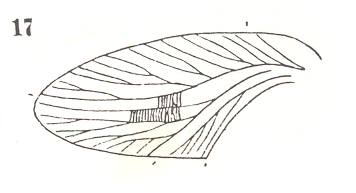
|
Frame 121 :
Nearoblatta exarata SCHLECHTENDAL
Family Poroblattinidae.
Length of tegmen about 8.5 mm.
Locality : Löbejün in Sachsen.
Stratum : Ottweiler Stufe,
upper Upper-Carboniferous.
(After HANDLIRSCH, 1906, Taf.XXX, fig.17, description p.292)
|
Frame 122 :
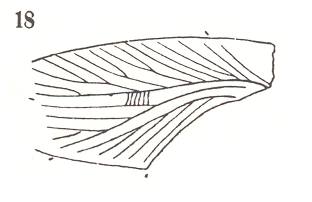
|
Frame 122 :
Nearoblatta pygmaea SCHLECHTENDAL
Family Poroblattinidae.
Length of fragment about 7 mm.
Locality : Wettin in Sachsen.
Stratum : Ottweiler Stufe,
upper Upper-Carboniferous.
(After HANDLIRSCH, 1906, Taf.XXX, fig.18, description p.292)
|
The Blattida incertae sedis (Blattoidea incertae sedis in HANDLIRSCH, 1906, pp.292) will not be dealt with here.
These, then, were all the Blattida from Wettin (near the town of Halle, Germany) and surroundings, as far as recorded up to 1912.
The fossil (upper upper Carboniferous) blattida fauna of this locality comprises four well-represented families, viz., Archimylacridae, Spiloblattinidae, Mylacridae, and Poroblattinidae, of which the latter two consist of rather small forms as compared to the first two.
Of the family Archimylaridae many species have been described from Wettin, especially of the genus Phyloblatta. Whether they, based on tegmina only, are genuine species is not so certain. Let us quote TILLYARD in Kansas Permian Insects, part 20 (I), The Cockroaches, or Order Blattaria, p.185-7, in American Journal of Science, 34, of the year 1937 :
Owing to the well-known variability of the venation in the wings of Cockroaches, it is extremely difficult to define the fossil species. Probably far more species have been named, especially in genera like Phyloblatta, than are reasonably justified. On a number of occasions I have drawn the venations of the left and right forewings of recent Cockroaches and have never found the branching of the main veins in the two wings the same. This variability has always to be borne in mind when attempting to fix the limits of fossil species, and I think it is preferable to err, where possible, on the side of broadness rather than of narrowness.
Nevertheless, we may safely say that the Wettin fossil blattida fauna has yielded more than, say, sixty, species. And this is significant enough. It shows that conditions there (and then) were very fit to sustain a rich Blattida fauna.
Evaluation and theoretical conclusion as a result of the composition of the palaeozoic Blattida fauna of Wettin and surroundings.
Because (1) the Blattida are poor flyers (their wings principally assist in jumping), (2) they have little ecological adaptability, and (3) [because] there is good reason to hold that the four basins (Saar, Wettin, Dunkard, Kuznets) were (at the time) more or less isolated spatially (like 'islands' in the landscape), geographically widely apart from each other, and, moreover, [because there is good reason to hold that] the large geographical regions separating them are ecologically unfit for them (to inhabit or to pass through) (dry and cold elevated regions, inland seas), -- it is clear that blattids (and also their egg-cases and larvae) cannot have spread by passive transport or active migration from one basin to another. Therefore it is also clear that the blattid families cannot have (each for themselves) evolved from a single region of origin (and then from there allegedly having migrated, while remaining morphologically largely the same as to their tegmina at least, into all directions). Each family must have originated -- in the Carboniferous -- polytopously (i.e. originated at more than one place) and therefore polyphyletically (i.e. having originated from different, independent stocks).
The evolution, which in our theory is the successive appearance of different forms (species) in the Explicate Order, is supposed by us to reflect, in an approximate way, the course of noëtic construction in the Implicate Order, the construction that is, of the overall strategies (morphologically as well as behaviorally taken) of the successively appearing species. This reflection is not necessarily expressed by the actual consecutive order of appearance in the Explicate Order, but only insofar as we can detect in the actually existing, or having existed, species derivational relations formally (and thus not necessarily temporally or genealogically) connecting these species. And such relations may be expressed in "polydiagrams" (for these, see the Section "Polyphyletic development of strategy-contents and their noëtic construction in the Implicate Order" in " Theoretic Intermezzo" after Part VIII (Heteropterygia)). In fossil Blattida we can follow (if at all) this noëtic construction only as to the venation of the forewings or tegmina. Because of the apparent individual variation in the venation, we should focus not so much on the precise number of branches and forks, but on the respective areas supported by the main venational systems, Sc, R, M, CuA, and perhaps on the structure of the clavus (including CuP or vena dividens).
The general tendency in the 'evolution' of the venation of the tegmina in palaeozoic Blattida is that the subcostal area, being initially moderate in extension with dichotomically split branches of Sc, is extending (i.e. lengthening) first, while the branches of it together become arranged into a more or less pectinate series. After this, the area of Sc is contracted again, and the anterior branches of the Radius (R) functionally replace those of Sc. We see this not until the Mesozoic. The Medial area may increase, or the CuA system may increase its number of branches. In the Poroblattinidae, however, the CuA system is strongly contracted. The anal veins may eventually end up, not in the margin of the clavus anymore, but in the vena dividens (CuP).
In the family Mylacridae the venation of the tegmen becomes more or less symmetrical with respect to the median axis of the wing. Further, the size of the tegmen in especially the Mylacridae and Poroblattinidae becomes quite small, in the order of a mere 10 mm long.
In all this, we have to find out whether all these tendencies in the venation in palaeozoic Blattida have occurred independently in a more or less large number of parallel lines, or not. As to the differences between (1) the more primitive members of the family Archimylacridae (with a radial [i.e. more or less fan-like] and dichotomical branching of Subcosta), (2) all the forms centering around Phyloblatta (moderately long Sc, with its branches comb-shaped arranged) and grading into the Spiloblattinidae (narrower wing with subparallel anterior and posterior wing borders, and with weaker archedictyon), (3) Mylacridae (symmetrical tegmen), and (4) Poroblattinidae (contracted CuA), -- we indeed see four (or perhaps five) different venational types of Blattida tegmina. And we suppose that derivational lines or series, that can be set up between these types or differences, reflect in some way the noëtic construction of strategies (in the Implicate Order) insofar as the venation of tegmina (being part of such a strategy) is concerned.
But these are the only genuine (i.e. constant) morphological differences (allowing to recognize types) occurring among palaeozoic Blattida tegmina. And there might be detectable, not one, but a whole bundle of parallel derivational lines or series, each one of them formally connecting these types, one with the other. But, in detecting such a bundle we may have been misled by the phenomenon of individual variation in the venation, and this could mean that there is in fact only one single overall derivational line or series seen in the Explicate Order reflecting the noëtic construction in the Implicate Order (as expressed in a "polydiagram" [see below] ). If so, it is to be expected that wherever we find forms that allegedly cannot be placed in this one derivational line as a result of apparent specialization-crossing, and thus should be considered to be members of another line parallel with the first one, the venational differences, causing the alleged specialization-crossing all fall within the range of mere individual variation, not representing different species at all, but individual variants of some species of the first derivational line. So it might be that in palaeozoic Blattida there is only one single derivational line -- as to the wing-venation of tegmina -- (if there is such a line at all !) reflecting the noëtic construction of every palaeozoic species of Blattida. That is to say, there is, it is true, a separate noëtic construction course for each species, but these courses only differ from one another in one or more of their final stages. See next drawing, schematically expressing a polydiagram.
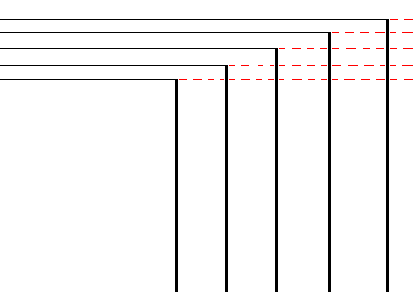
Diagram above : Ascending noëtic construction lines (bold vertical black lines), each one leading to a different species. As to their structure (construction-stages) these lines are reflected by derivational lines -- in fact one derivational line -- in the Explicate Order (horizontal thin black lines, each of them being a part of the same overall derivational line), and differ from each other only in their terminal parts (these differences symbolized by their different heights).
There must, of course, exist a great many of such vertical construction lines (because there were many palaeozoic Blattida species), and when we, in such a completed diagram, go from left to right we will pass from one venational type to the next. And there are four or five such types on the basis of the mentioned venational differences and tendencies.
In order to fully appreciate the exposition of the noëtic construction of blattida tegmina (and of strategies in general) with the help of so-called "polydiagrams", the reader may consult the two-document " Theoretic Intermezzo" which is inserted into the present series of documents after part VIII (Heteropterygia). For "polydiagrams" in particular the reader should, in that same " Theoretic Intermezzo", consult the Section Polyphyletic development of strategy-contents and their noëtic construction in the Implicate Order (to be found at about the last sixth of the (first) document).
As we shall see in the next document, we can formally pass through these venational types in roughly three (parallel) ways, which means that at least three (instead of only one) derivational lines can be detected, formally connecting these types with one another in the Explicate Order, and, as we shall also see in the next document, each segment of such a (horizontal) derivational line corresponds to a (vertical) noëtic construction line in the Implicate Order, where "corresponds" means that the construction-stages in the noëtic lines are more or less reflected in the derivational lines formally connecting the venational types.
The great majority of Blattida tegmina are of, or stand close to, the phyloblatta-type including even the lower Permian forms of Kansas (Permoblattina, and Pycnoblattina) which were assessed by TILLYARD (1937) to belong to the family Spiloblattinidae (and thus to the spiloblattinid type).
So what is indeed the most conspicuous feature of the Blattida of the Saar, Wettin, Dunkard, and Kuznets basins, is their great venational similarity. All the many different 'species' of the genus Phyloblatta are based on minor venational details, of which many may, however, accounted for by individual variation. Indeed, the various taxa of fossil Blattida, distinguished by authors, in the faunae of these basins (and other localities) may simply be no more than mere parataxonomical categories instead of true genealogical or typological taxa, because in virtually all cases all we have are tegmina or fragments of them.
So it is indeed the existing great similarity, or, often, even (qualitative) identity, of forms, that is conspicuous when we compare Saar-blattida or Wettin-blattida with either Dunkard- or Kuznets-blattida, or with any other palaeozoic blattida for that matter. And it is this similarity between forms widely separated from each other by ecological and geographical barriers, that convinces us of their polyphyletic origin. And the very fact that such an origin is possible at all, makes polyphyletic origin of all insects, and of all organisms for that matter, at least less problematic to suppose.
For the phyloblatta-type, at least, we may say that it will appear everwhere where existing ecological existential conditions are such as to demand a strategy of some particular type (venationally expressed in the phyloblatta-type), which [strategy-type], apparently, necessarily implies the phyloblatta-type of tegmen, either by functional reasons, or as a result of noëtic 'constructionalist' constraints (in the latter case such tegmina, as to their phyloblatta-venation and shape, are necessary by-products or concurrent structures in the noëtic construction of the strategy-content). And such a particular strategy-type, and thus with it the phyloblatta venational type, independently appears in the Explicate Order wherever, in this Order, the corresponding ecological existentional conditions are met.
"Blattopterygia" is (or, at least, is meant to be) a functional wing-type, which is confined to the Order Blattida only, and splits up into the four above mentioned morphological (i.e. venational) types, or, let us say, subtypes : archaic archimylacrid subtype, phyloblatta subtype, poroblattinid subtype and mylacrid subtype. Maybe we could add the spiloblattinid subtype (grading off from the phyloblatta subtype). The species possessing them appear where appropriate conditions prevail.
Blattopterygia, considered in itself, as part of a strategy, is more or less self-contained and homogeneous. Therefore, we cannot say anything significant of its noëtic creation from (a likeness of) some other type or types, neither (can we say anything particularly significant with any certainty) of the noëtic construction of each of the mentioned morphological subtypes within blattopterygia, and even if we can, it is purely hypothetically so (see next document) : Indeed, we may formally connect these venational subtypes with each other and so account for the origin of some of them from the other subtypes, but the direction of venational derivation, if these subtypes are derivationally connected with one another at all, is not clear (for instance, is the Subcostal area contracting or lengthening ?) and is (next document) determined more or less subjectively. All this does not, however, diminish the heuristic and methodical value of the blattida-polydiagrams in the next document.
And also precisely whereto (at least a likeness of) blattopterygia has led, if to anything at all, we cannot say, except, perhaps, that it has led to the wing-apparatus of termites (Mastotermes).
Polyphyletic origin of Blattopterygia, because this wing-type is present in Blattida only, means that the various blattid groups, and perhaps even all the blattid species, appeared independently of each other in the Explicate Order. And this further means that it is only in their noëtic construction, in the Implicate Order, that they are connected with one another in a certain way : Each noëtic ascending line (ending up in some blattid strategy-content, and here only considered insofar as tegminal venation is concerned), is a succession of noëtic construction stages, which (succession) is more or less reflected by the venational differences between the above mentioned morphological subtypes of Blattopterygia, or at least [such construction stages] do involve the venational structures of some of them.
We shall work this out in the next document -- before continuing with the other two basins [Dunkard and Kuznets] having supported palaeozoic Blattida -- in the form of polydiagrams, although realizing that much uncertainty is involed here, as a result of the (absolute) fragmentary nature of fossils, and as a result of the great individual venational variability that can be assumed (also) in the palaeozoic Blattida.
With this we conclude the exposition of the blattarian fauna of Wettin. In the next-next document we will describe the Blattarian fauna of the Lower Permian of the Dunkard Basin, S.E. United States.
e-mail :  ( Please write in ' Subject ' entry : ' METAPHYSICS ', in order for me to be able to distinguish your mail from spam )
( Please write in ' Subject ' entry : ' METAPHYSICS ', in order for me to be able to distinguish your mail from spam )
To continue click HERE for an exposition of the noëtic construction of the various palaeozoic Blattida tegmina
Back to Homepage
Back to Contents
Fifth Part of Website
Back to Part I
Back to Part II
Back to Part III
Back to Part IIIa
Back to Part IIIaa


 ( Please write in ' Subject ' entry : ' METAPHYSICS ', in order for me to be able to distinguish your mail from spam )
( Please write in ' Subject ' entry : ' METAPHYSICS ', in order for me to be able to distinguish your mail from spam )





















 ( Please write in ' Subject ' entry : ' METAPHYSICS ', in order for me to be able to distinguish your mail from spam )
( Please write in ' Subject ' entry : ' METAPHYSICS ', in order for me to be able to distinguish your mail from spam )